#trick or treat 1986 imagine
Explore tagged Tumblr posts
Text
🎃Halloween Media Recommendations!🎃



It's October which means it's time for Halloween! I don't go trick or treating anymore so instead I celebrate by watching spooky-themed shows and movies. A lot of the normal Halloween movie recommendations are too scary for me,so here are some that are perfect for littles and caregivers that like something more light-hearted. This one will be mainly shows and movies aimed at younger littles, I'll have more recommendations for bigger kids in the next post
Dividers by @/kodaswrld
Shows/Show episodes will be in bold
Bump In The Night (1994)
The Trap Door (1986)
Room on The Broom (2012)
Ruffus The Dog (1989) - Dr. Jekyll & Mr. Hyde
The Gruffalo (2009)
Eureeka's Castle (1989) - It Came From Beneath The Bed
The Magic School Bus (1984) - A Magic School Bus Halloween
Charlie and Lola (2005) - What Can I Wear for Halloween?
The House with Clocks in Its Walls (2018)
Sesame Street: A Magical Halloween Adventure / Sesame Street: Trick Or Treat On Sesame Street / Sesame Street: Elmo Says Boo!
Gullah Gullah Island (1994) - Gullah Gullah Ghoul-land
Kipper The Dog (1997) - The Little Ghost
Scary Godmother (2003)
Scary Godmother 2: The Revenge of Jimmy (2005)
Fraggle Rock (1983) - The Terrible Tunnel / Scared Silly / A Dark and Stormy Night
Craig of the Creek (2018) - Trick or Creek/ The Legend of The Library
Bear in The Big Blue House (1997) - Halloween Bear
Pajanimals (2010) - Scary Costumes
Clifford's Puppy Days (2003) - The Halloween Bandit / Boo!
Angelina Ballerina (2003) - Henry's Halloween
Rubbadubbers (2004) - Finbar and the Ghosts
Kiki's Delivery Service (1990)
The Wiggles (1998) - Spooky Monsters
Imagination Movers (2008) - Haunted Halloween
Spirited Away (2002)
Make Way for Noddy (2002) - Don't Be Scared,Noddy
Raggedy Ann and Andy in The Pumpkin Who Couldn't Smile (1979)
Raggedy Ann & Andy: A Musical Adventure (1977) [Not Halloween themed but it scared me a lot so I'm counting it]
Little Bear - Moonlight Serenade / Caterpillars / Goblin Night / How to Scare Ghosts / Night of Full Moon / Up All Night
Claymation Comedy of Horrors (1991)
Blues Clues - What Is Blue Afraid Of? / Blue's Big Costume Party
I tried to pick shows and movies that aren't on a lot of other Halloween recommendation lists and some I remember from my childhood. Thanks for reading and I'll leave you all off with a bunch of Halloween commercials I really like. Have a safe and spooky Halloween!
#halloween agere#halloween#spooky season#halloween vibes#happy halloween#halloween reccomendation#movie recommendation#tv show recommendations#age regression#sfw agere#age regressive#agere little#sfw age regression#age regressor
12 notes
·
View notes
Text
NSFW Headcanons~ Sammi Curr

(Not my gif)(Requested by anonymous)
(Following in the movies metal “god” portrayal of Sammi, I’m using BD for before death Sammi and AD for after death Sammi. :) )
- While I don’t think it changes the way he behaves astronomically, I do think it should be noted that Sammi BD acts at least somewhat differently than Sammi AD. Sammi BD is a bit more lighthearted than his undead counterpart and is more likely to genuinely love you/be in a relationship with you; while Sammi AD is more concerned with the amount of control he has over you.
- Either way, your boyfriend got around. He was a half naked, world famous, heavy metal Rockstar: if he wasn’t doing it with equally famous celebrities, he was doing it with the dozens of groupies he had throwing themselves at him every night.
- I’m sorry but did you see that tongue?? AD Sammi is definitely more of a receiver than a giver; unless he’s got an ulterior motive for really pleasuring you, but BD Sammi was definitely a fan of going down on you, and was damn good at it too. He’d get off on seeing you come undone and that twinge of surprise and nervous anticipation in your eyes once he crawled between your thighs.
- But speaking of AD Sammi, he’s got a selection of sensual superpowers to choose from and he’s more than happy to use them on you; especially when he thinks it’ll benefit him. Disembodied and invisible hands raking across your body and undressing you, a feeling of electricity washing across your entire figure, a ghostly energy pulsing deep inside you: it’s times like those that you remember exactly why you’ve sold your soul to him.
- Electricity play is somewhat unavoidable: it comes off him in drives so while he isn’t going out of his way to taser your womb, he is undoubtedly giving off waves of energy; making every part of you stand on end, and occasionally delivering a shock to some part of you when you get particularly mouthy with him.
- I mentioned it before but AD Sammi is definitely more of a receiver; especially when he thinks your loyalty to him is waning. Every now and again, you’ll have to assure him that you’d do anything for him; getting down on your knees and waiting for his next command as he stares down at you with a subtly pleased expression on his face.
- Foreplay? Oh, you mean staring at him in awe and anticipation as he walks around your room? Just Kidding; but also not really. Both versions of Sammi tend to take their time in the bedroom so foreplay is usually a mix of cat and mouse comments, skillful touching, and your natural response to him towering over and fixing his attention on you.
- Speaking of touching: he does a lot of it. Sammi is consistently feeling you up: groping and grabbing and running his hands down your body; even if they’re technically not really there. He’ll also use his long acrylics to trace down your skin and make you shiver; loving the way you arch your back at his barely there touch.
- He’ll be especially handsy when you wear things with leather and/or black lace. He’s a sucker for it before and after death.
- BD Sammi is closer to being a switch than anything else. He isn’t really set in one role and typically likes to switch it up throughout the night; rolling around in the sheets with you and just doing what feels right/fulfills what you’re both trying to accomplish. Being wild and enjoying yourselves was his main goal.
- AD Sammi is almost entirely dominant and borders on being “your master” in and out of the bedroom. If it isn’t completely a thing then there’s definitely hints of a master and slave/servant dynamic when the two of you are together and that’s just the way that he likes it. He loves knowing that you’re completely under his spell.
- Speaking of his spell: a big part of his allure is how little you have to worry about when the two of you are together. Being with him; especially after his death, is like having a wet dream: your anxieties and self consciousness sort of just melt away. The first few times your together, it’s like your head is spinning in the best way possible and that feeling gets to be pretty addictive.
- The only thing you have to worry about is his reaction to you defying him or letting him down; or maybe even a bit of jealousy....
- Depending on your relationship with him, jealousy and possessiveness can be a pretty big part of your sex life; especially after he dies. In his eyes, he “owns” you, so seeing you with other men is not something he particularly enjoys; especially if the two of you had an actual relationship prior to his fiery death.
- You’d be trying to move on and date other guys, and his ghostly presence would watch from the sidelines before wrenching the door off the hinges of your dates car and disposing of his body. Don’t you know who you belong to? Now he’s really going to have to remind you.
- Yet, regardless of his mood, his pace still stays the same. He’ll usually either take things slow and steady; focusing on being sensual and making you burn with desire, or go hard and deep; usually with a bit of a quickened pace. Some nights he does both and alternates between the two whenever he pleases.
- Speaking of some nights: he’s the type of person who likes to go all night. He’s got a hell of a libido so as long as you’re up for round after round, he is too.
- Doggy style is definitely his favorite position but he’s also a fan of trying new things so whatever fits the mood or helps him accomplish what he’s trying to accomplish will be used as well.
- Quickies before or after his concerts; usually in his dressing room or a secluded corner backstage..
- Considering the fact that he bit into and drake a snakes blood on stage, I think it’s safe to say that blood doesn’t scare him. If you’re on your period, he’s still raring to go: whether that includes using his hands, his mouth, or his other appendages.
- And, while we’re talking about getting messy, let’s talk about his lipstick kink. I think he’d be a big fan of smearing yours across your face or seeing his own spread across your body; quite literally leaving his mark for anyone and everyone to see.
- Lipstick marks aren’t the only things he leaves behind, though. He sends you off with a patchwork of hickeys and bitemarks to show off to all your friends as well, and if you have a habit of trying to cover them up, he’ll make it so that you can’t.
- He’s not a complete masochist but he does like a little bit of pain with his pleasure so don’t be scared to give him a few of his own bite marks or dig your heels/nails into his back. It’s probably how you manage to get yourself a call back before the two of you started dating during his “alive years”.
- Regardless of whether he’s alive or dead, I have a feeling that he’d get off on taking you in your bed, surrounded by your photos and posters and records of him. He’d like the slight ego trip that it gives him and the idea that he was “making your dreams come true”; even if you were just roleplaying.
- Roleplaying between the two of you typically revolves around groupie scenarios: well, either groupies or good girls being defiled by bad boys. He kind of likes the idea of corrupting you; even if it’s just pretend.
- Sammi is packing and I refuse to believe otherwise. He’s not hung like a horse but he is longer than average and girthy and for that reason, he is very proud.
- Birth control is definitely the best option when your with him; you might even want to throw in a bit of witchcraft while you’re at it because I wouldn’t trust regular old pills to save you. I also wouldn’t trust him to remember to put on a condom or even just trust him to put one on in general, and AD Sammi is exactly the sort of entity to purposefully make you into the mother of a literal hellspawn.
- He’s not terribly loving during aftercare; especially after death, but he does take care of you when he thinks that it’s necessary: whether that be carrying you off to bed, saying something sweet/as sweet as he’s capable of, or leaving you with a passionate and heated kiss. Typically though, he leaves you limp in bed, completely satiated while he reminds you not to let him down and to fulfill your duties as his humble human servant.
#sammi curr imagine#sammi curr headcanons#sammi curr headcanon#sammi curr imagines#trick or treat imagine#trick or treat 1986#trick or treat imagines#trick or treat headcanons#trick or treat headcanon#trick or treat 1986 imagine#80s movie imagines#80s movie headcanons#80s movie imagine#80s movie headcanon
51 notes
·
View notes
Photo

Trick or Treat 👻 Happy Hallowe’en 🎃 For the first time since about 1986, I’m wearing a @bencooperco plastic costume-in-a-box costume for #Halloween 😎 I have worn the vintage kids’ version of this #Batman costume before when I was, like, 6 so you can imagine my excitement to learn that #BenCooper makes some of the classic costumes in adult-size these days 🥸 Paired with my 2022 McBoo bucket from @mcdonalds I’m ready to hit the streets for trick-or-treating 🍭🍬🍫 Yes, folks, believe it or not, I am currently single 💀 (at Toluca Lake, California) https://www.instagram.com/p/CkYsn2-JuJ5/?igshid=NGJjMDIxMWI=
2 notes
·
View notes
Text
Last night I watched Trick or Treat aka Ragman (1986), which is about a metalhead named Eddie (who accidentally resurrects his recently deceased metal idol) and that sure was a trip haha
I mean, Eddie’s not an uncommon name but still!
(I also, of course, started imagining Eddie watching it when it’s released—because he’s 100% still alive in October 1986—and being like ‘about time they made a movie about me*!’
It’s so good though and I can’t believe I hadn’t watched it before! Ozzy Osbourne has a bit part as a preacher fighting against heavy metal and the lead is played by Skippy from Family Ties! (Gene Simmons is in it too)
*Although the Eddie in the film is more of a loner and is bullied quite brutally :(
3 notes
·
View notes
Photo




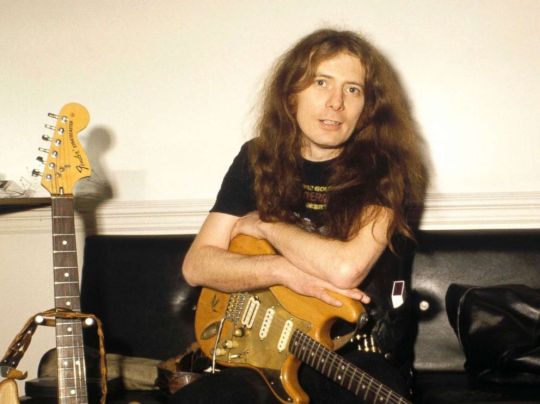





Today we remember the passing of "Fast" Eddie Clarke who died January 10, 2018 in London, England
Edward Allan Clarke, better known as "Fast" Eddie Clarke, was a British guitarist who was a member of heavy metal bands Fastway and Motörhead. Of Motörhead's classic lineup, which consisted of Lemmy, himself and Phil "Philthy Animal" Taylor, he was the last surviving member at the time of his death.
Clarke began playing guitar and, by the time he was fifteen years old, had been through many local bands, one of which was called The Bitter End. Of his "Fast" moniker, Clarke has said "I didn't get the name Fast Eddie because of any sex thing, and it wasn't even because I could play fast. It was just that I could play one note in a solo really fast," referring to his skillful tremolo picking.
He continued playing local gigs until 1973, when he turned professional by joining Curtis Knight's blues prog rock band, Zeus, as lead guitarist. In 1974, the band recorded an album called The Second Coming at Olympic Studios. Clarke wrote the music to Knight's lyrics on a track entitled "The Confession".
Clarke recorded the album Sea of Time with Zeus. Later, with guitarist friend Allan Callan, keyboard player Nicky Hogarth, and drummer Chris Perry, Clarke attended a recorded jam session at Command Studios in Piccadilly. As a result of the tracks from this session, the quartet secured a deal with Anchor Records, and called the band Blue Goose. With a recording contract secured, Clarke, Hogarth and Perry left Zeus to focus on their own project with Callan.
Clarke soon formed another band with Be-Bop Deluxe bassist Charlie Tumahai vocalist Ann McCluskie, and Jim Thompson on drums. Called Continuous Performance, this line up lasted until early 1975, when their demo tracks failed to secure them a record deal and the band split up. Still out to secure a record deal, Clarke then formed a group with Nicky Hogarth from Blue Goose, bass player Tony Cussons and drummer Terry Slater. Their efforts to get a deal were also unsuccessful, and Clarke temporarily gave up the music industry.
Clarke was working on re-fitting a houseboat, when he met drummer Phil Taylor, who had recently joined Motörhead. However, according to Kilmister's authorized biography, it appears that Clarke was introduced to Lemmy by a receptionist at the rehearsal studio, Gertie, who was romantically involved with Clarke at the time. Not long after, he was playing with them. In the early days Eddie rehearsed with Motörhead, before going on the road, at Snobs Rehearsal Studios, part of a converted brewery on the corner of Kings Road and Lots Road, Chelsea, known as the "Furniture Cave". Motörhead's popularity increased along with their UK chart successes. The threesome (Lemmy, Clarke, Taylor) are considered the classic Motörhead line-up and have the Motörhead, Overkill, Ace of Spades, Bomber, No Sleep 'til Hammersmith and Iron Fist albums plus a string of hit singles to their credit.
He performed a lead vocal on five Motörhead songs: "Beer Drinkers and Hell Raisers" (on which he traded vocals with Lemmy), "I'm Your Witchdoctor" (on which he duets vocals with Lemmy), "Step Down", and "Emergency", one of the B-side tracks on the St. Valentine's Day Massacre EP, upon which they performed "Please Don't Touch", with Girlschool, under the combined band names of Headgirl.
Clarke left Motörhead in 1982, whilst on tour of the United States. Becoming unhappy at the results of the Iron Fist album, the recording sessions with the Plasmatics were the final straw. For the B-side of the Stand By Your Man EP the bands took turns in covering each other's songs, Clarke felt that this compromised the band's principles and resigned. According to Joel McIver, Clarke himself later denied this version of events and had said: "[Philthy] was the main instigator in my being excluded from the band. Notice I do not call it leaving, as it was not my choice. I had imagined dying onstage with Motörhead, so it was a blow when they didn’t want me in the band any longer." Clarke was replaced by former Thin Lizzy and Wild Horses lead guitarist Brian Robertson after Anvil frontman Steve "Lips" Kudlow turned down the offer to play with Motörhead. Clarke's last gig with Motörhead took place at the New York Palladium on 14 May 1982. Another cameo from Clarke on a later Motörhead album was on 2000's Live at Brixton Academy, released in 2003, on which the band featured many guest appearances from other guitarists, of which he was one, playing on the songs "No Class", "The Chase Is Better Than the Catch" and "Overkill".
Hearing that UFO bassist Pete Way was keen to leave that band, the two met and decided their new band's name would be an amalgamation of their own two names, resulting in Fastway. They advertised in the music press for a drummer and a vocalist. Meanwhile a rehearsal was organised, for which Clash drummer Topper Headon filled in on drums. The ads began showing positive results, cassettes from potential band members arrived; one of these was from a young singer named Dave King.
Clarke was impressed with his voice and financed a trip to London for King; after an audition together, King became the Fastway vocalist. Ex-Humble Pie member Jerry Shirley became the drummer. The band sent out demo tapes and were approached by CBS Records for a recording deal. Way announced his departure just as they were about to sign the deal, but CBS had faith in Fastway and decided to sign them despite this setback.
Touring had been strenuous for the band and, upon returning to Britain, they decided to split. Clarke stayed in London, and soon received a call from King about giving Fastway another go. Clarke agreed and moved to Ireland. With another album for CBS in view, they rehearsed with three of King's friends. The record label was happy with the sound and had them record at London's Abbey Road Studios with producer Terry Manning, releasing Waiting for the Roar in 1986. Clarke toured America with Fastway, supporting AC/DC, followed by a lengthy European tour, which produced 1992's Say What You Will – Live album. Fastway were also engaged to provide music for the Trick Or Treat film soundtrack, for which they composed the title track and performed "Heft" and "If You Could See" from their albums.
After the band split up again, Clarke moved back to London and met up with Lea Hart, a solo artist in the Far East. Clarke's record deals had now expired, so the pair took a demo tape to Douglas Smith (Clarke's former Motörhead manager) at GWR Records, who willingly signed a deal. Still using the name Fastway, they recorded the On Target album. It featured Don Airey and Paul Airey on keyboards, Neil Murray on bass, plus Bram Tchaikovsky of The Motors and Christine Byford as backing vocalists.
Clarke's group now consisted of Riff Raff on drums, keyboards and bass, plus assorted friends helping out; Biff Byford and Nigel Glockler of Saxon, Don Airey, and Kim McAuliffe and Cris Bonacci of Girlschool. Following the production of two albums, Clarke and Hart split up.
However, the excesses he had indulged in with Motörhead had taken their toll, and led to Clarke being admitted to hospital, spending time afterwards in recuperation. Having recovered, Clarke released a solo album, It Ain't Over Till It's Over, which blends Motörhead and Fastway styles. Lemmy also helped out on the album by writing and singing the track "Laugh at the Devil". The double CD release, Fast Eddie Clarke Anthology, on Sanctuary Records showcased a collection of Clarke's music spanning his career before and after Motörhead. It also marked a return to live performances with a re-formed Fastway, including an appearance in the UK at the Download Festival in summer 2007.
In 2014, Clarke went back to his blues roots and released a new studio album through Secret Records. Make My Day: Back To Blues was a collaboration between Clarke and the keyboardist from Shakatak, Bill Sharpe. Clarke reunited with Lemmy on 6 November 2014 at the National Indoor Arena in Birmingham to play the Motörhead track, "Ace of Spades".
Clarke died on 10 January 2018, aged 67, in a hospital where he was being treated for pneumonia.
8 notes
·
View notes
Text
KATIE’S TOP 10 15 WORST ROYAL WEDDING DRESSES OF ALL TIME
15. Silvia Sommerlath in Dior by Marc Bohan (Sweden, m. King Carl XVI Gustaf, 19 June 1976)

I love a good simple wedding dress, but this thing needed a tailor from the heavens to save it. It looks like she’s wearing a bedsheet, or a nightgown. The veil is fine, but I hate the little short part just dangling from the Cameo tiara in midair. I don’t hate the whole look in theory, but a lot of adjustments needed to be made for it to work, especially since she went from commoner straight to Queen.
14. Marie-Chantal Miller in Valentino (Greece, m. Crown Prince Pavlos, 1 July 1995)

This is a case of way too much going on. It looks like the designer took pretty parts of multiple wedding dresses and sewed them together without seeing that the individual concepts worked well together. This thing has mismatched lace, I mean, come on. Also, the corset does her no favors.
13. Sophie Rhys-Jones in Samantha Shaw (United Kingdom, m. Prince Edward, 19 June 1999)

Beaded jewelry - especially a cross - does not belong anywhere near a royal wedding. The dress is way too plain, even for my ordinarily plain taste. It looks like a nightgown. The bouquet and veil were nice, but that necklace is just terrible. Combined with quite the unfortunate tiara, this bridal look missed the mark in a lot of ways.
12. Charlotte Casiraghi in Chanel Haute Couture and Giambattista Valli (Monaco, m. Dimitri Rassam, 1 June 2019)


I couldn’t decide which of Charlotte’s two gowns (excluding the short Saint Laurent by Anthony Vaccarello from her civil ceremony) was worse, so I chose both for this spot. The Chanel didn’t fit her anywhere, and those shoes need to be burned in a fire. The fabric is wrinkly and heavy and the bodice drowns her. The Giambattista Valli looked like all of the elements of a typical boho beach wedding, but all sewn together in some haphazard, last-minute fashion. There’s just too much going on - lace and mesh and ruffles and appliqué and polka dots and tulle and wide sleeves. I genuinely hate them both, especially since I had such high hopes.
11. Mabel Wisse Smit in Victor & Rolf (The Netherlands, m. Prince Friso, 24 April 2004)
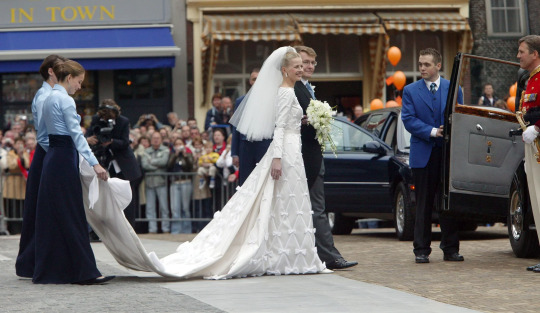
I don’t hate the silhouette, but that super short veil and those bows have to go. The bows literally ascend in size down the train - I just don’t get it. I can’t get it. This could have been a success if it wasn’t so heavy (weighed down by those ridiculous bows) but the small details just kill the entire thing for me.
10. Marilène van den Broek in Pierre Yves (The Netherlands, m. Prince Maurits, 29 May 1988)
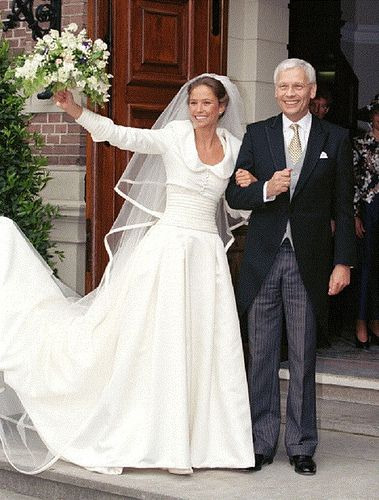
Wedding dresses should never have collars, and you should never see the ribbing of the corset through the fabric. It looks like Pierre Yves missed the entire midsection of fabric and just decided to let Marilène walk out with her lingerie showing. The collar would be weird on a shirt, let alone on a wedding dress. I hate it.
9. Sarah Ferguson in Lindka Cierach (United Kingdom, m. Prince Andrew, 23 July 1986)

The 80s were a terrible era for fashion. I hate satin with a passion - it is possibly the ugliest fabric on the face of the earth. Combine that with shoulder pads and puffy sleeves... yikes. The skirt of the dress looked wrinkled (satin is the least forgiving fabric) and her veil swallowed her entire head and her hair - which is almost impressive, considering one can ordinarily see Sarah’s hair from the International Space Station. Also, those bows on the veil... nope. Bows just seem so juvenile for such a massive event. This is just a case of 80s fashion gone wrong - at least the proportions were right, but the rest of it completely missed the mark.
8. Masako Owada in Jun Ashida (Japan, m. Crown Prince Naruhito, 9 June 1993)

Another case of too much happening at once. The lace is pretty but combined with the excessively ruffled collar, buttons, elbow-length gloves in a mismatched fabric/color, matching handbag (??), and over-the-top necklace and tiara (which I love, but not with this), the look in full is... unfortunate. Also, I hate with a passion when royal ladies in gowns cover their sashes. This was the day she became the Crown Princess of Japan - that sash is a lot more important than that ugly little overcoat!! The sash should always go over the outfit. Period.
7. Letizia Ortiz in Manuel Pertegaz (Spain, m. The Prince of Asturias, 22 May 2004)
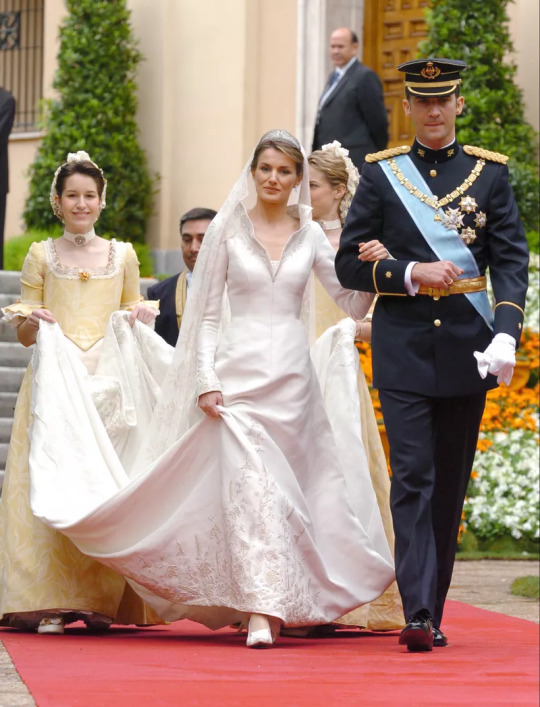
I’ve said it once, I’ll say it again - wedding dresses should not have collars. For someone whose fashion almost always knocks it out of the park, I’m flabbergasted that Letizia chose this look for her wedding day. It looks like she’s wearing a camisole underneath to bring up the neckline... I used to do that when I was 13. It wasn’t a good look for a teenage American, and it’s not a good look for a future Queen on her wedding day. Also, the fabric swallows her petite figure alive. The shape is closer to a nightgown than to a wedding dress.
6. Princess Märtha-Louise in Wenche Lyche (Norway, m. Ari Behn, 24 May 2002)
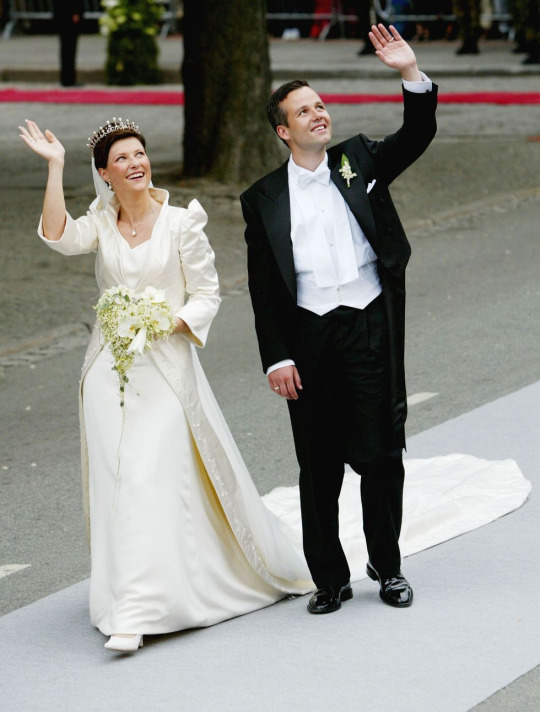
Wedding!! dresses!! should!! not!!! have!! collars!!! The only thing worse than a collar is a jacket... Märtha-Louise went with both in this case. The color is unforgiving and the jacket doesn’t match the slip dress beneath it. I think I like the tiara individually but it just does not work with the dress/vampire cape thing she has going on.
5. Mathilde d'Udekem d'Acoz in Édouard Vermeulen (Belgium, m. Prince Philippe, 4 December 1999)
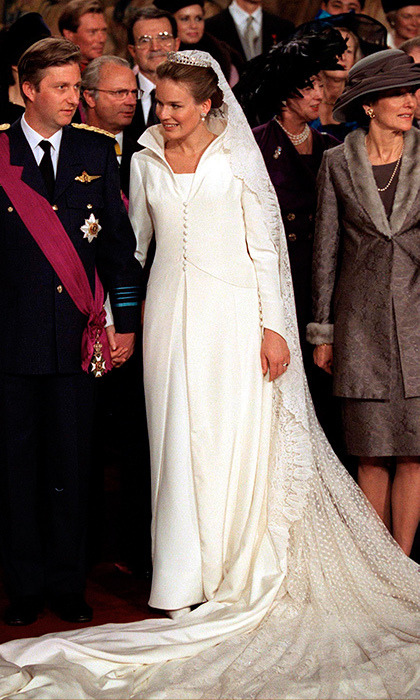
Honestly, I’m getting tired of saying it, but... wedding dresses should not have collars. The color is pretty but that’s about all I can say about this dress. What’s with those polka dots? Who on earth would think that polka dots and ruffles should go in the same veil? With lace? And tulle? It looks like the designer took all of the leftover fabric from his past designs and stitched them into a ridiculously mismatched veil that was paired with an extraordinary simple dress (that would have been fine on its own, had the collar/coat thing been totally eliminated). Seriously, these collars make all of these gorgeous royal ladies look like Dracula.
4. Rania al-Yassin in Bruce Oldfield (Jordan, m. King Abdullah II, 10 June 1993)
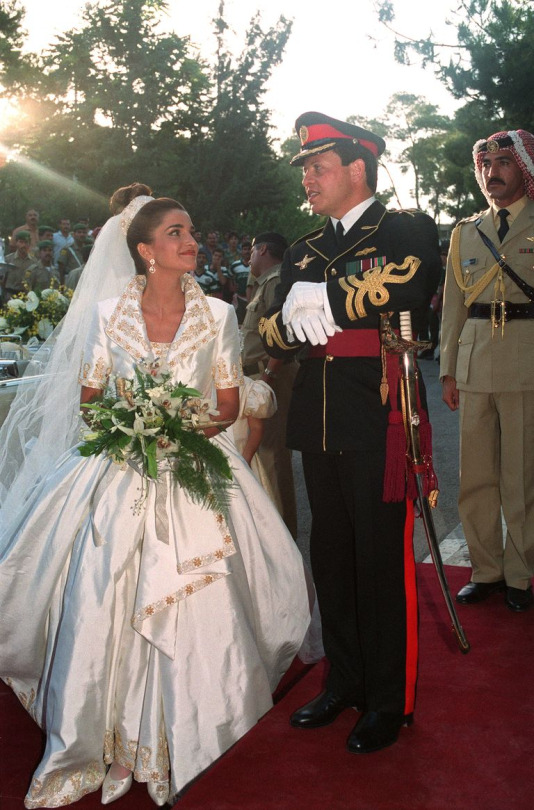
This like something you could get at Party City for $75.00 so a child can call herself “The Bride of Franken-Elvis” while trick-or-treating on Halloween. Seriously, what is it with these ladies and their collars? That embroidery... no. It’d be bad enough if it was white or silver, but the fact that it’s gold? Just no. And it’s repeated on her shoes!! Short-sleeved jackets are simply the worst, especially over a wedding dress. The fabric is unforgiving (I hate satin) and the whole thing looks like it was just pulled out of a suitcase before being thrown on the bride. The bouquet is terrible, the earrings are terrible, the hair is terrible... why does it look like the veil is both pulling on Rania’s scalp and strangling her beehive? I don’t get it, I hate it, I can’t imagine why anyone would think any part of this ensemble looked good.
3. Mary Donaldson in Uffe Frank (Denmark, m. Crown Prince Frederik, 14 May 2004)

By far, the worst wedding ensemble of all the modern royal brides. Mary has such an incredible fashion sense, which is why this one hurts so much. What is going on here? A bad case of wedding hair, for one - suffocated of course by an ugly tiara, excessive earrings, and a veil that looks like it just came out of someone’s attic, unpreserved and yellow-tinted. The same goes with the dress - what’s wrong with the color? Why does it look like it’s been sitting in a studio with a bunch of chain smokers for a year? The color just washes her out completely. The shape isn’t horrible but those weird panels on the front look like they were sewn on the morning of the wedding as an afterthought. I hate the fabric, I hate the sleeves, I hate the fabric, I hate the design execution, I hate the veil, I hate the bouquet, I hate the accessories... overall, I hate the whole thing.
2. Soraya Esfandiary-Bahktiary in Christian Dior (Iran, m. Shah Mohammed Reza Pahlavi, 12 February 1951)

Feathers... just no. Nope, no way. I have nothing good to say. I have nothing to say. Just no.
1. Lady Diana Spencer in David and Elizabeth Emmanuel (United Kingdom, m. The Prince of Wales, 29 July 1981)

The epitome of god-awful 80s fashion. I get that hindsight is 20-20 but I can’t believe that anyone on Diana’s design team would think this thing would age well. It looks like it weighed more than Diana ever did! Puffy sleeves, ruffles, mounds and mounds of ridiculous, wrinkled fabric... it’s a wonder she wasn’t sucking wind by the time she got to the altar! It’s like a workout!! Who needs to go to the gym when you could just put on Diana’s wedding dress and walk a couple hundred feet? For such a young, beautiful bride - this entire thing missed every mark. It wore her, not the other way around. She was barely out of her teens when she wore this and it just aged her... I could do this forever. This is one of the worst royal wedding dresses of all time, then and now, and I can’t fathom anyone ever approving this design much less wearing it down the aisle during the wedding of the century.
#my post#katie's top 10-15#katie's worst wedding dresses#queen silvia#crown princess marie-chantal#sophie rhys-jones#countess of wessex#chaarlotte casiraghi#princess mabel#princess mariléne#sarah ferguson#duchess of york#empress masako#queen letizia#princess martha-louise#queen mathilde#queen rania#crown princess mary#queen soraya#princess diana#Princess of Wales#lady diana spencer
36 notes
·
View notes
Text
It Chapter Two: Aged-Up Protagonists and the Umbridge Effect

Writing reviews, metas, and the like is a lot about timing. If you don’t craft your writing in the immediate aftermath of your source’s release, someone else will beat you to it and, chances are, your audience will be less enthused about reading the same arguments weeks later. (Admittedly, that’s up for debate. I for one am happy to read about the same shit for years on end.) Thus, when I didn’t have the time or the mental energy to write about It: Chapter Two immediately after seeing it in theaters, I knew within a few days that I’d lost a lot of ground. Fans and critics alike have already spoken about the film’s major draws, namely the update on Richie’s sexuality and the canonizing of a beloved, thirty-year-old ship. We’ve also covered the issues that arose out of those positives. In 2019, is it necessary to show a hate crime in such violent detail? By giving us queer characters, have Muschietti and King unintentionally fallen into the trap of treating them badly? One is dead and the other mourns while the straight couple passionately kiss beneath the lake. Faithful adaptation vs. modern activism is a tricky balance to strike. I could rehash all those arguments here, but why bother? They’ve been articulated better by others already. Besides, falling behind means that I now have the space to discuss something just as important to me.
The Losers’ ages.
Now, I’m not sure if you all have noticed, but fantasy adventures aren’t really geared towards adults. That is to say, stories often contain adult content, but that’s not the same thing as putting adults at the center of the narrative. I’ve experienced a niggling sense of displeasure that’s grown stronger with each passing year and it took until my mid-twenties to figure out what it was: I am no longer the hero of many of my favorite stories. Because I’ve grown up. Harry Potter is concerned primarily with the trials and tribulations of characters between the ages of eleven and eighteen. If we return to that world---such as through a certain cursed play---the focus must shift to the new, shiny generation. Anyone who falls through a wardrobe is bound to be a child and if they dare grow up? They’re no longer allowed access to such a fantastic place. Kids are the ones who find the Hundred Acre Woods, or fall down rabbit holes, get daemons, battle Other Mothers when the world gets flipped, or head off onto all sorts of elementary and high school adventures. Sometimes, even those who are adults mistakenly get caught up in this trend. Frodo might be in his fifties, but as a small, kindly hobbit he comes across as younger than the rest of the Fellowship. Since the release of Jackson’s trilogy I’ve corrected more than one new fan who assumed (somewhat logically) that he is in his early twenties, max. It’s an easy mistake to make when we’ve grown accustomed to children and young adults taking center stage in so many fantastic, high-profile adventures.
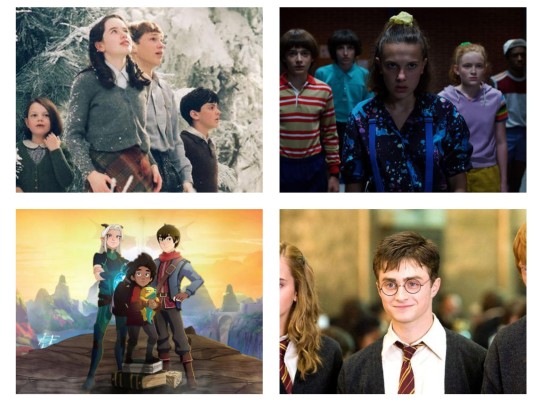
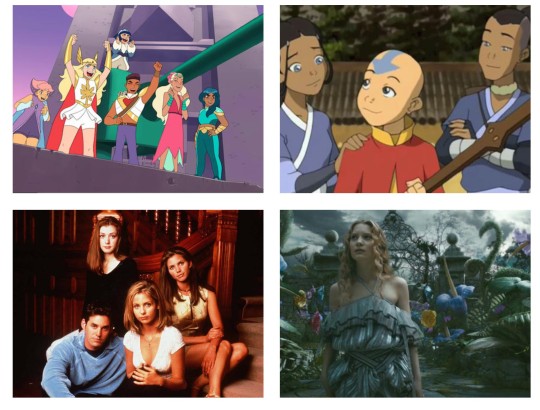
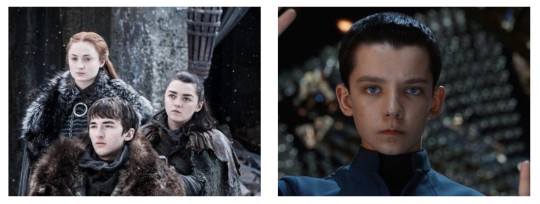
Of course, there are plenty of counters to this feeling. Just look at Game of Thrones. Though we see much of the story through younger perspectives---such as the Stark siblings---the vast majority of the cast is made up of adults, playing just as pivotal a role as the up-and-comers. Fantasy, Science Fiction, and other speculative story-lines are by no means solely in the hands of minors, yet I think it’s also worth acknowledging that a good majority of those stories do shape our media landscape. Or, if they’re not strictly minors, they’re characters who embody a sort of static young adulthood, the Winchesters and the Shadowhunters and all the television superheroes who might gesture towards markers of adulthood---we have long term relationships, hold down jobs, can impersonate FBI agents without anyone batting an eye---yet are still able to maintain a nebulous form of youth. They all (try to) look and act as if they’re right out of college. The standards of film and television demand that actors appear twenty-years-old even when they’re pushing forty, and the standards of much literature insists that twenty is simply too old for an adventure, period. I can still clearly recall two moments of shock (later agreed upon by my friends) when I encountered unexpectedly older protagonists in genre fiction: the realization that Sophie actually spends the majority of Howl’s Moving Castle as a very old woman and that The Magicians takes place in graduate school. “Wow,” I remember thinking. “When’s the last time that happened?”

What does all this have to do with It: Chapter Two? I don’t have any big twist for you here. It was just really refreshing to see such a fantastical story where our cast is all forty or older. Seriously, can we take a moment to appreciate exactly how much King undermined expectations there? The first half of the novel is structured precisely how we assume it ‘should’ be. There’s a mysterious threat, there are children caught up in the middle of it, and ultimately only they are capable of saving the day. We know this story. We even have the characterization of the town itself to reinforce this structure, a place so warped by evil that only the very young with their open-mindedness and imagination are capable of seeing Derry for what it truly is, illustrated beautifully in the film by Mr. Marsh straight up not noticing a whole room full of blood.
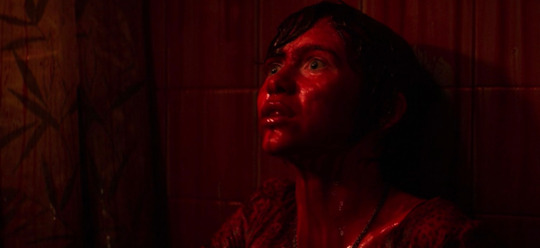
Though they’re It’s prey, children are also the only ones who have any potential power over him. You have to be able to acknowledge a problem in order to fix it and King could have easily ended his story at the first chapter alone, with the group somehow managing to defeat Pennywise for good the first time they set foot in the sewers. A part of me is still shocked he didn’t, if only because the young savior as an archetype was embedded within Western culture far earlier than It’s 1986 publication. From Carrie to The Girl Who Loved Tom Gordon, Pet Sematary to Firestarter, King is no stranger to putting children at the center of fantastic tales. Yet he’s also given us numerous adult protagonists, managing to find an enjoyable balance between the two, both within individual novels and his entire corpus. It represents that balance, not just imagining a story where seven (yes, I’m counting Stan) middle-age adults manage to finally save their town, but actually setting up a twenty-seven year jump to allow for that. It's the best of both worlds, exploring the difficulties inherent in both childhood and adulthood, arguing that we need each---that imagination and that experience---if we hope to come out alive.
While watching It: Chapter Two I took note of how many people laughed throughout the film, and not just at the moments set up to be funny (looking at you, Richie). Rather, the film that two years ago had scared the pants off of movie-goers now entertained them in a much more relaxed manner. No one was hiding behind their popcorn; there were no shrieks of fright. I’ve seen more than one reviewer express displeasure at this change. What the hell happened? Isn’t an It film supposed to be scary? Well, yes and no. I think what a lot of people miss is how providing us with an adult cast inherently changes the way fear manifests, both literally in the case of Pennywise’s illusions and thematically in regards to the film itself. This sloppy bitch, as established, preys on children. His tricks have the illogical, fantastical veneer that reflect how children see the world: you’re scared of women with horrifically elongated faces, zombie-like lepers, and hungry mummies. They’re literal monsters emerging out from under the bed. Of course, as adults watching the story we’re easily able to see how these monsters represent much deeper, intangible fears: growing up and disappointing your father, falling ill like your mother always claims you will (to say nothing of contracting AIDS in connection with a budding queer identity), and the danger that comes with being alone and ostracized. Sometimes It: Chapter One gestures more firmly towards those underlying fears---such as the burnt hands reaching for Mike when we know his family died in a fire---but only once does it make the real horror overt, when Pennywise takes Mr. Marsh’s face and asks Bev if she's still his little girl.
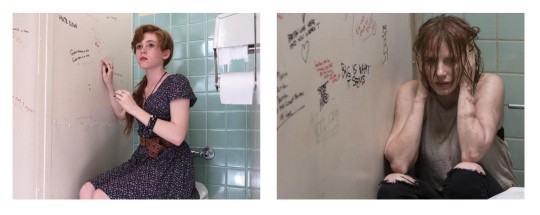
Outside of pedophilia and sexual abuse, Chapter One’s real horror is mostly coded, symbolic, left up to (admittedly rather obvious at times) interpretation. It’s just under the surface and we’re meant to be distracted by the fact that, allegorical or not, there’s still a very creepy thing hunting our protagonists from the shadows. For two hours we take on a child’s perspective, biting our nails at all the things we once imagined hid inside our closets. We’re scared because they’re scared.
That mindset irrevocably changes once your group grows up. Forty-year-olds simply don’t freak out in the same way a bunch of thirteen-year-olds would, especially now that they know precisely what’s happening and have the mental fortitude to combat it. At least to an extent. Chapter Two isn’t as traditionally scary for the simple reason that the film now acknowledges what all adults eventually must: there’s nothing in the closet, there’s nothing hiding under your bed. Or if there is, it’s something tangible that can be handled with a calm(ish) demeanor and a well-placed ax. An adult might scream when something jumps out at them, but they’re not as inclined to cower. Adults might still be scared, but they’re better able to push that fear aside in order to take action. The group first reached that point in the sewers--- “Welcome to the Losers’ club, asshole!”---and now fully embodies that mindset with nearly three decades of growth and experience to draw on. This is why Ben investigating the library as a teen reads as teeth-chatteringly scary, but Ben and Bill as adults investigating the skateboard produces only a comment about how they're getting used to this nonsense. They know, and we as the audience know, what the real threat is and whether or not we need to shield our eyes when something starts clunking its way down the stairs.
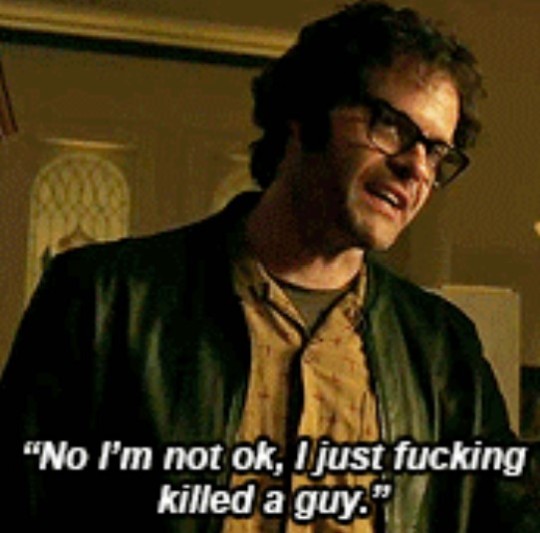
All of which isn’t to say that Chapter Two isn’t scary. It’s simply scary in a much more realistic manner, killer clowns and Native American rituals aside. The fears have been aged-up along with the cast, stripping away the child-like fantasies that made us wet our pants in Chapter One. What’s the scariest moment outside of the jump scares? When two men and a kid beat a gay man and then chuck him in the river to drown. You’ll note that, unlike in the first film, Pennywise doesn’t actually have to do much work here. Seasoning people up with fear? The rest of the world is doing that for him. That first scene detailing a truly horrific hate crime (which, by the way, is based off of true events) results in a meal delivered straight to Pennywise’s arms. It’s people who targeted that couple, beat one of them within an inch of his life, and then tossed him over a bridge, bleeding and shrieking for help. All Pennywise had to do was scoop him from the water and take that first bite. He’s incidental to the film’s most cringe-worthy scene. We can argue all we want about how it’s Pennywise’s influence that “makes” the town this way, but any queer viewer knows that's simply not the case. In 2019 we're still living this horror, no Pennywise required.
Likewise, the two children we see murdered are much more overtly grappling with fears that have nothing to do with fantastical monsters. Dean, the little boy Bill tries to save in lieu of Georgie, is rightly petrified because a seemingly crazy adult is now stalking him. We as the audience know that Bill is just trying to help----that he’s not the real danger here----but that’s not the perspective this kid has, nor is it the issue the film is grappling with. We first see him approaching an idol of his, Richie, and instead of an enjoyable experience he winds up getting yelled at. The It films are only tangentially interested in the status of fans and their relationship with celebrities, but we know it’s a common theme for King’s work overall. Look at Misery and look at this cameo: a disenchanted fan of the 21st century, criticizing a writer’s novel and leveraging him for money. “You can afford it,” he tells Bill, swindling him simply because he can. The context of this little boy as a fan and Richie as the older, bigger, larger-than-life comedian adds another layer to the interaction. It’s not just an adult verbally attacking a child, it’s an adult this kid worshiped enough to recognize and quote his material from memory. Who easily walks away from that?
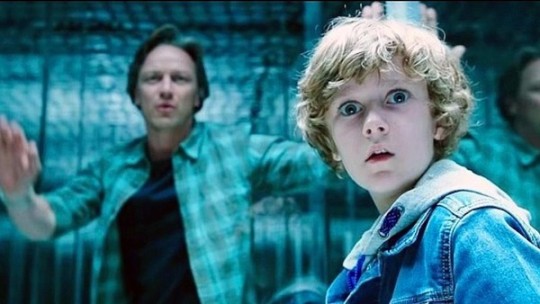
This little boy then finds Bill shrieking at a sewer opening, is manhandled by him, and told in the scariest way possible, born of Bill’s own fear, that he has to get out of dodge, fast. There are scary things out there, Dean freely admits that he’s heard kids’ voices coming from the tub drain, but right now the scariest thing is how badly the adults in his life are failing him: parents (from what little we can gather) are distant, his comedic idol is mean, and now this stranger is traumatizing him in the middle of the street. Once again, it’s easy to see how Pennywise isn’t needed to sow fear or even enact cruelty; he’s not a requirement for horrible things in the world, he’s merely their reflection. We see the same setup with the little girl under the bleachers. That scene demonstrates precisely how not scary Pennywise is. Here’s this child putting aside her discomfort over his looks and agreeing to be his friend. What’s worse than a clown with a creepy expression? The knowledge that all the other kids have already rejected you because of a birthmark on your face. Bullying is the far greater threat and one we’re 100% more likely to deal with in our lives than a killer clown, so the second film re-frames Pennywise to better acknowledge this. He’s scary because things like bullying and neglect exist to give him an easy in. He’s even scary because in this moment, hiding under the bleachers, manipulating this little girl, he’s fully embodying a child predator. Chapter One was a primal, “There’s a monster hiding in the shadows” kind of fear. Chapter Two is a, “We’re all going to die from climate change” kind of fear. Logical and largely inescapable. Characters like Richie don't need Pennywise to take some fantastic form to scare him. Homophobia has already done all the work.
Ultimately, I think of this as the Umbridge Effect. Who’s the most hated character in the Harry Potter franchise? I’ll give you a hint, it’s not the Dark Lord responsible for two wars, attempted genocide, and the death of our title character.

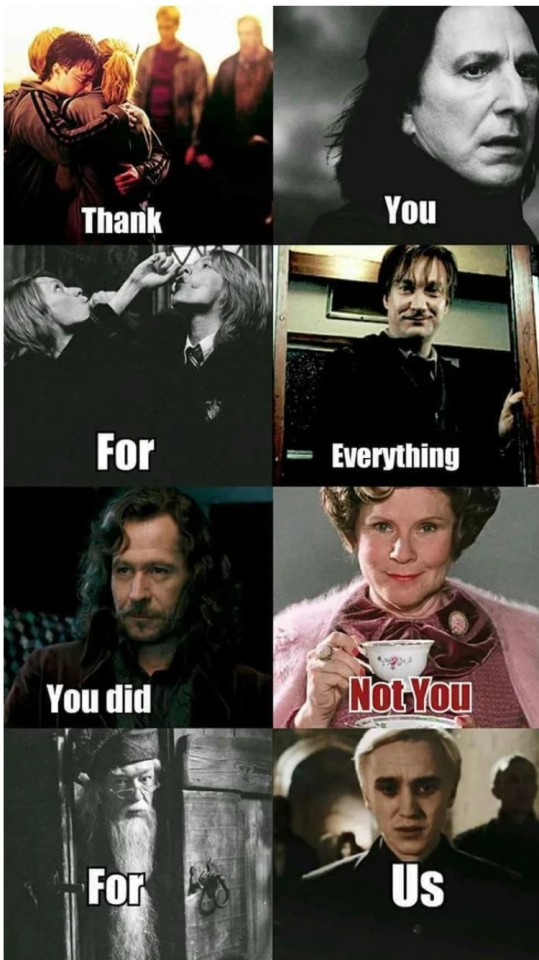

We despise Umbridge because she’s real. She’s relatable. She’s grounded in a way that Voldemort could never hope to be. We have no fear that an all-powerful sorcerer is suddenly going to come out of the woodwork and attempt to enslave and/or eradicate everyone without magic. That’s just not on our list of things to worry about. A corrupt politician, however? An instructor who uses her power to emotionally and physically torture students, getting away with it because of a cutesy, hyper-feminine persona? We’ve seen stuff like that. We’ve lived it. Umbridge represents all the real wrongs in the world when it comes to bigotry and privilege. Therefore we hate her---we fear her---in a way we could never hate or fear Voldemort. Now, in It: Chapter Two, Pennywise is the new Voldemort. Is an alien clown with an unhinged jaw and three rows of teeth technically scary? Sure, but it doesn’t hold a candle to the real problems that plague the cast: abuse, anxiety, depression, suicidal ideation, the fear that someone will hurt or outright kill you over some part of your identity. These are things we continue to fear long after the credits roll and the lights come up, and they’re now barely coded in the story:
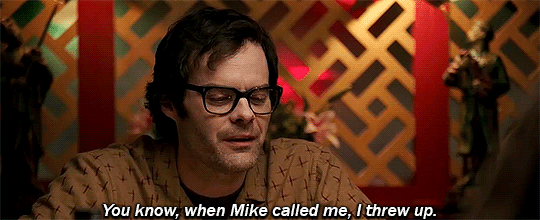
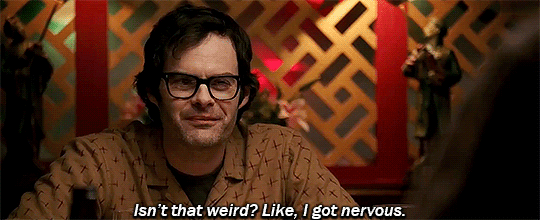
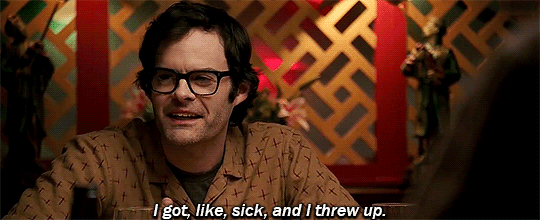
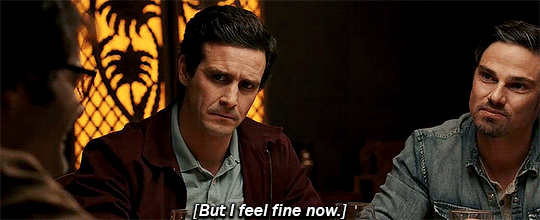

It occurred to me halfway through my viewing that the people laughing at the characters’ new plights were the same ones who didn’t flinch when a gay man’s head cracked into the pavement. I had both hands over my mouth during that scene and I wasn’t snickering whenever Eddie had a panic attack, or Ben’s self-confidence took a hit. Because those moments, like our opening, hit pretty close to home for me; I didn’t find them embarrassingly humorous in the way much of my theater did. So many reviews in the last two months have insisted that Chapter Two isn't scary, but I think that depends entirely on whether or not you're struggling with these now explicit threats. We're not dealing with mummies and creepy portraits anymore. Instead, tell me how you feel about holding your partner's hand in public. Do certain memories make you vomit? Or freeze? Consider heading upstairs to the bath? The horror is dependent on how the audience views Bill's stutter coming back, or the bruises on Bev's arms.
The cast grew up. It’s a fantastic twist. It also means that the horror needed to grow up with them, resulting in a film that could no longer function as a simple, scary clown movie. Our ending reminds us of that. When did people laugh the loudest? When the Losers’ club was bullying Pennywise into something vulnerable. And yeah, I get it. It’s a cheesy moment that we feel the need to laugh at because it’s just so unexpected. Awkward, even. Since when are badass horror monsters defeated with a bit of backyard peer pressure straight out of middle school? If this were any other story, Pennywise would have been defeated by Eddie’s poker. The most scared member of the group finally finds his courage! He has faith that this simple object can kill monsters! He throws it in a perfect arc, splitting the deadlights in two! That’s a heroic ending. Something epic and fantastical, relying on the idea that the Good Guys will win simply because they believe in themselves... but that’s not how the real world works. That ending is a child’s fantasy. Sometimes you do the heroic thing and end up dying anyway. Which isn’t to say that the heroic thing is useless. It saves Richie’s life. It’s just that a single act can’t cure all our ills in the way that storybooks often claim they can.
How then does an adult deal with huge, intangible problems like bigotry and mental illness---the things Pennywise now fully represents? By saying “Fuck you” to those things again and again with all the support you can possibly wrangle up at your side. You refuse to let those issues control you; you drag those child-like representations into the light and remind yourself just how small they really are. We don’t get to beat something like depression by spearing it with a fire poker in some overblown finale. If we did, we’d all be having a much better time. All you can do is band together with friends and scream that you’re not going to let your fears define you anymore. Pennywise is a symptom of all the true horrors in the world. Sadly, you can’t beat those with a baseball bat. But you can acknowledge the heart of the issue, literally in the case of five friends squeezing until that one symptom, at least, is gone.
Image Credit
#1:https://www.screengeek.net/2018/07/10/it-chapter-2-character-mashups/
#2:https://earlybirdbooks.com/the-re-read-the-lion-the-witch-and-the-wardrobe
#3:https://www.vox.com/culture/2019/7/4/19413771/stranger-things-season-3-review-recap-hopper-elevenrussians
#4:https://comicbook.com/movies/2019/08/08/harry-potter-movies-review-10-years-late-snape-dumbledore-franchise/
#5:https://www.denofgeek.com/us/tv/netflix/277257/give-the-dragon-prince-a-chance
#6:https://www.forbes.com/sites/lindamaleh/2019/04/23/she-ra-and-the-princesses-of-power-season-2-review/#ec7022c42953
#7:https://www.commonsensemedia.org/tv-reviews/avatar-the-last-airbender
#8:https://www.newsweek.com/buffy-vampire-slayer-turns-20-charisma-carpenter-shows-enduring-legacy-and-566123
#9:http://theinspirationroom.com/daily/2009/alice-in-wonderland-the-movie/
#10:https://www.hindustantimes.com/tv/game-of-thrones-this-edited-out-scene-between-bran-and-sansa-reveals-so-much-about-finale/story-qFDHflH2dO6Kcki1wgsEyM.html
#11:https://www.cinemablend.com/new/Why-Ender-Game-Best-Possible-Adaptation-Book-40110.html
#12:https://www.hollywoodreporter.com/live-feed/supernatural-end-season-15-cw-1196579
#13:https://www.slashfilm.com/it-chapter-two-scene/
#14:https://www.vox.com/culture/2017/9/12/16286316/it-cleaning-up-blood-scene-feminism
#15:http://www.allocine.fr/film/fichefilm-208633/photos/detail/?cmediafile=21647122
#16:https://stanleyyuris.tumblr.com/post/188300897715/chaotic-losers
#17:https://whatculture.com/film/it-chapter-2-every-character-ranked-worst-to-best?page=3
#18:https://www.reddit.com/r/harrypotter/comments/7uhrkz/the_most_hated_character/
#19:https://9gag.com/gag/am2X2Z4?ref=pn.mw
#20:https://screenrant.com/harry-potter-hated-characters-unpopular-worst-ranked/quickview/17
GIFs1-5:https://the-pretty-poisons.tumblr.com/post/188344826978/why-is-everyone-looking-at-me-\like-this
71 notes
·
View notes
Note
What if Joyce and her kids and Hop and his (including Max if you want cus I can’t get enough how you write her and Billy’s relationship) all went on a road trip together?!
(okay i know i have other asks before this that i need to respond to but) I LOVE THIS SO MUCH AND I’M!!!! CRYIN!! (also thanks so much for the lovely compliment ohmydear♥i love writing them too it’s so fun)
Okay so i read this and i was like: ohman they’d have to take 2 cars or something bc there’s Joyce + Will and Jonathan and then Hop + El and Billy and then Max?? That’s 7 of them! But tHEN
IMAGINE THEM ALL IN A VW BUS!!!
Joyce is a hippie in my headcanon bc I love that shit and she could show the boys hippie music and help them through life w/ it and so anyway I’d like to think she’s aLWAYS wanted a VW bus. they’re just… cute as hell and so damn cool and she could decorate the inside w/ cute curtains and i just love that so much. so now imagine Billy and Jonathan knowing she’s always wanted one and Jonathan never having seen one but Billy having seen them everywhere in Cali and knowing exactly what Joyce is talking about and they both save up a SHIT. TON. of money (bc i dunno how expensive they were back then but they’re pretty cool cars that a lot of people wanted and they’re big, so) and Will and El even help out by mowing lawns for people or picking up a paper route (Jonathan doesn’t like the idea of them working but they insist) and they buy a used 1968 Kombi VW bus and Billy fixes it up a bit and it’s a faded light blue color and it’s definitely not pristine, it definitely looks a little loved, but it’s perfect and they all help fix up the interior and it’s??? The most beautiful thing. And they give it to her for her birthday or Christmas or something and Joyce cries an absolute RIVER and would hug them all for hours if Hop hadn’t torn her away to let them breathe
So anyway, when Billy and Jonathan graduate from high school in 1986 (i don’t wanna do all the math on when Billy’s birthday would have to be and when school cut offs are but Jonathan and Billy were both born in ‘67 sooooo) Joyce wants to go on a road trip w/ everyone!!!!! Bc how exciting!! and really it’s Joyce’s idea bc Jim doesn’t really like dealing w/ lots of people in one place but Joyce knows all the kids love Disney movies and she’s also always wanted to go to Disney World so they go! And they bring Max along bc El begs and pleads and Billy thinks it’d be good for her to get out of the house and Joyce 100% agrees bc even though Neil hasn’t done anything, the energy is negative and that shit affects a kid, y’know?? Plus they all love Max and would so adopt her if they could so she’s able to convince her mom and she goes w/ them and! just!
Imagine them all packed into a big VW bus w/ little floral curtains and funky retro seat covers, on the road at 7:30am and Joyce agreeing to drive the first few hours bc Hop is useless in the morning and conks out immediately once they get in. El and Will do too, El on Max’s shoulder and Will on Jonathan’s as Jonathan and Billy and Max start arguing for like, a good half hour about what music they should listen to on the trip down until there’s a lull in the fight and Joyce says she only brought her tapes of 60s and 70s music. so they all get educated on good hippie music.
and Billy and Max love each other, they do. they had a bumpy relationship when Billy was living at home before but they’re a lot closer now and they’ve been siblings for years now. but they’re just both such fiery personalities that they bicker more than half the time down. It’s a 16 hour drive (maybe even more??? If there are more roads now than in 1986) so it takes them 2 days and they’re so bratty towards each other.
So they’re all trying to explain what Disney World is to El who is still rather confused.
“We’re going to…. Another world?”
“What’s a… roller… coaster?”
“You mean Mickey Mouse is real??”
And that one makes Max giggle and shake her head.
“It’s like… Santa. People dress up as him and other characters and you can take pictures and stuff.” she gives a dangerous smirk then, turning around to look at Billy. “Billy’s afraid of them.”
“I am not.” He growls, kicking at her seat but trying not to kick too hard bc they worked too hard to get this van looking nice.
“You totally used to cry at anyone in a costume. We barely got to go trick or treating that one year because you were so freaked out.”
“Because our asshole neighbor was dressed as Jason and chased me down the fucking street!”
“Language!” Hop yells at the same time as Jonathan snorts. Billy reaches over Will to pinch Jonathan hard.
“Is that why you were shaking when we saw Mickey Mouse that one time?”
“That was on the Walk of Fame. Everyone is afraid of those guys because they’re all a bunch of coke addicts!”
“Coke… addicts?” El asks and everyone pauses, Jonathan letting out another snort.
“Like Coke and Pepsi?” El asks, and everyone immediately agrees while Jonathan laughs a bit.
“Yeah! Coke and Pepsi!” Joyce agrees, while Hop turns and gives them a harsh look to stop this conversation.
Joyce asks what character El is most excited to see. Joyce says that she herself hopes that they have Winnie the Pooh bc he’s her absolute favorite.
“I like Alice.” she says with a smile. It had kind of scared El when she first saw it, but she thought the colors were cool and Alice is just as curious as El is.
“I hope they have Peter Pan.” Max says a little dreamily.
“You just like him because he’s a ginger like you.” Billy snarks, to which Max sends him a harsh look.
“You like him too! We used to watch that movie all the time when we were little.”
And she’s right, they did. It makes him smile. Maybe there’s some psychological reason- the idea of a cute boy coming by to take him away from his terrible life and whisk him away to a magical world is pretty fucking nice -but he’s not about to overanalyze himself. And if anyone were to ask what he’s most excited for, he definitely wouldn’t admit that it’s Peter Pan.
“I like Peter Pan too.” Will admits, to which Max turns to look at him.
“Isn’t he cute?”
Will nods with a slight blush.
“Who’s Peter Pan?”
Max is distraught at El’s question.
“You haven’t seen Peter Pan???” She turns to Jonathan. “What are you guys doing depriving her of Peter Pan?”
“She’s with you more often than us!” Billy is indignant. “What have you been doing, not showing her Peter Pan?”
Max sticks her tongue out. Jonathan says he’s looking forward to Tomorrow Land and all of the parade floats. When Billy is asked, he mumbles something about wanting to ride all the big rides like Space Mountain and Thunder Mountain.
“What about you, Dad?” El asks happily.
“I’m just excited for the food.” Hopper grunts.
So yes, lots of bickering with the occasional break to listen to whatever song is playing. And you fuckin bet they bicker over where to stop to eat, too, until Hop decides for them all.
And i was trying to look up different, more obscure theme parks or attractions for them to go to but I just… couldn’t get over the idea of all of them getting matching Mickey Mouse ears. bc just… think about it. Think about a picture of all of them gathered in front of the castle wearing their Mickey Mouse hats, Hop and Joyce w/ an arm around the other, Joyce leaning up against Hop, El and Will smiling the biggest and cheesiest smiles with El’s arm around Will’s shoulder, Jonathan giving a little shy smile bc he feels pretty dumb, Max getting the biggest kick out of Billy freaking out over ruining his hair but giving him an expectant look until he puts the hat on, Billy yanking a strand of her hair out right before the photo is taken and Max shrieking so they have to take another one and when they do Billy rests his arm on Max’s head and max is stepping on Billy’s foot but they chuckle about it afterwards, giving irritated looks that break into smiles.
And i just?????? Jonathan buys Nancy a little bracelet with a Minnie Mouse charm on it and a stuffed version of Piglet from Winnie the Pooh and Billy gets Steve a little stuffed Bambi and a shirt that says “Princess” in big letters and gets himself a matching one that says “Prince Charming”. Steve pretends to be less than impressed but he blushes when Billy mumbles something about how he couldn’t stop looking at the castle and thinking of his princess back home and i just??? I have so many ideas about this Hopper Family Vacation to Disney World AUGH i love this.
(and if you want their Road Trip Playlist just ask me bc i just?? imagine their little van driving back up to Indiana on a calm road through a little patch of tall trees while Harvest Moon plays and its golden hour and Jim is driving and Joyce has her head leaning back against the seat, humming along and the sun is making it look like she’s glowing and Jim is a little worried about swerving bc he just wants to look at her. And Billy is leaning back in his seat all the way in the back, arm out the open window next to him as he waves it around in the soft air. Will and Jonathan are asleep on each other next to him and Max turns around from where she’s sitting in front of Billy to ask him something and sees her brother looking so damn calm. Just so serene and happy, a content smile on his face and golden sun hitting his blond hair gracefully as he blinks slowly. And she can’t think of what she was going to say bc it feels surreal to have this kind of moment w/ a family that feels so oddly whole. And Billy notices her staring and turns to her and she just sticks her tongue out and makes a funny face. Billy swipes gently at the air in front of her a few times w/ his left hand, chuckling a bit. She tries to kick him but she can’t reach and he just huffs a big, sharp breath in her face and she reaches to smack him as they both start giggling. then a soft click comes from their left and they see El has taken a picture of them on her little disposable camera she got on the way there and Max turns back around to talk to El and ask about how many pictures she thinks she’s taken and Billy turns back to look out the window, watching farms pass by in a haze, colored by the soft orange light of the sun, as he hugs the little Bambi plushie he bought for Steve and thinks about how comfortable happiness feels.)
#billy hargrove#chief jim hopper#eleven#el hopper#jane hopper#joyce byers#jonathan byers#will byers#max mayfield#steve harrington#harringrove#stranger things#bratty billy#bratty max#billy hopper#billy gets adopted#hopper is a dad#an Uncomfortable one as he walks around disney world#fluff#i LOVED THIS#thank you for this#cuz i'm cryin over here now#♥!!!#i love you guys so much and i love this AUGH#ask#anonymous
83 notes
·
View notes
Text
The Hollow Kingdom
Review and Defense of a classic fantasy favorite.
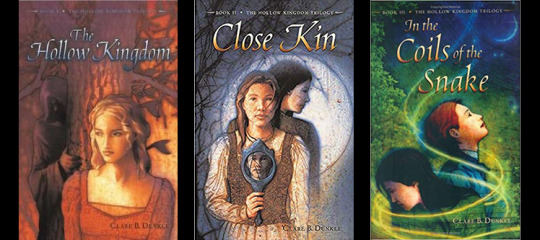
Warning: Below is a large explanation that spoils some upcoming projects and talks about things you may be uncomfortable with, but are important to talk about. Also, spoilers of the book.
Please consider reading the book!
There’s a stage that man girls go through, likely after watching the 1986 Labyrinth. I like to call it the ‘Goblin King Craze’. After all, few things match the childhood spectacle of David Bowie dancing in very tight pants with his cohort of bumbling goblins, coupled with the magic of Jim Henson.
I can imagine many of you who have watched this movie, had like me, also longed for the imagination and craze in your own life, or at least something similar in fiction.
Cue being a teenager, and discovering The Hollow Kingdom (published 2003), but mere chance in your hometown library.
Here is the Goodreads summary: “In nineteenth-century England, a powerful sorcerer and King of the Goblins chooses Kate, the elder of two orphan girls recently arrived at their ancestral home, Hallow Hill, to become his bride and queen...”
It’s no surprise that I ended up loving this book.
This book is generally under a YA fiction/fantasy tag. It has won various awards, including the 2004 Mythopoeic Fantasy Award for Children's Literature. It’s well-written, relatable to a young woman, and full of intelligent moments and clever thinking. The characters are fully-fledged, as are the societies they live in.
It’s not a perfect book. Sometimes the pacing and choice of focus can be inconsistent, and sometimes the timing and structure are not as strong as they could be. Its lack of care for developing romance can cause problems with the reviewers, had they been expecting a romance.
Now let’s chat a bit. As a teenager, it was an eye open experience to discover a book that didn’t pander another tale of ‘Beauty and the Beast’ once again. Meaning, an easy tale that force-fed me obvious morals, and condescended to my 'age-level’. And, I thought, it was better to talk about difficult things then pretend they didn’t exist.
And so time passed, the internet grew, and the Me Too movement rolled along, said hi, and sorta gave a half-hearted wave as it did so. Now, much older, I have finally had time to work on some projects that I’ve been thinking about for a long time. I do fanfic’s as a writing exercise, but my true love is illustrating stories on the webtoon platform. I have a series called ‘Vixen’ out that has been a trial run of sorts to sharpen my skills and get me back on track.
One of the long-running projects that I’ve desperately wanted to illustrate for a long time is ‘The Hollow Kingdom’. I am only in the beginning steps and have yet to contact the author or any of the other relevant sources. This research stage is mostly an exploration to see if this is even possible, and how it would be done.
As I’ve delved into the internet to see how my old favorite has aged... I was a bit startled.
Despite its initial accolades around 2018, when a lot of Hollywood was being stripped and scattered, and there were many accusations worldwide of prominent figures accused of sexual abuse, perhaps it was predictable that a complicated book that does not deal with a traditional happy ending started becoming maligned in general. And as social media, as a rule, tends to ignore content in favor of a thoughtful readthrough, I felt the need to go reread and reassess my POV.
So I did.
And I still enjoyed the book. As did the roughly 10,000 others who rated it 4 stars and above.
But to be fair, here are some reviews from other who didn’t:
----
1. The end is some sort of apologia for rape, abduction, and Stockholm Syndrome.
2. I expect that when I’m told said female protagonist is intelligent for her to actually be intelligent, like you know, by giving her any ounce of sense, resourcefulness, or deductive skills.
3. (The Goblin King)...seriously tries to justify his actions by saying he doesn’t have a choice...
4. I also did not like the pointless slaughtering of animals…which really if you think about it made no sense…why would the monkey and wolf not be threats and be all for following kate but not the bear or the snakes…
5. It didn't help that I was well aware of how the main character got tricked. I mean, if her guardian believed her and was concerned for her sister why would still keep Kate locked up in her room and offer freedom from the room in exchange for info on goblins?
6. A young woman is coerced into marrying the Goblin King, Lord of the Hollow Kingdom.
7. What I'm trying to get across is that this is another example of a story where a young woman gets virtually everything taken away from her - her passions, her freedom, everything - but (through Stockholm Syndrome or sheer stupidity, I'm not sure) she forgives it all in the name of love and becomes a supremely contented Stepford Wife.
8. So a girl is kidnapped by the Goblin King, and is trapped in the goblin kingdom. The end. Well, she ends up liking it, doesn't struggle, doesn't really care about what is happening to her.
-------
Sorry, that was a lot. I understand that there are many who are just not going to jibe with a book. But I think it’s fair that on the complaints that accuse the book, it can be rebutted.
1(a). Perhaps many of the problems with the book that people expected it to be the perfect mash between Labyrinth and Beauty and the Beast. First of all, Beauty and the Beast is a classic tale, which many accuse of Stockholm Syndrome. It isn’t, by the way, but that’s not why I’m here. Or here.
Neither is the Hollow Kingdom. It seems that many of the reviewers are sure that Kate is forced into marrying the Goblin King. She wasn’t. She actually ends up going to the Goblin King and agreeing to marry him in exchange for the release of her sister.
But Gav-san, the Goblin King )Marak) misled Kate into thinking they had her.
No, they didn’t. It even points out that had she asked, they would have told her. It’s stated very early on that Goblin do not lie under any circumstance (though are prone to being crafty beasts).
Kate never is isolated with her captour, or ignore his awful parts and has does not fall in line with his ideas, holding strongly to her own. In fact, it’s her very ideals that lead to her success in the end, and that leads to Marak’s change of ideology. Kate’s own honor often compelled her to make choices that seem frustrating to the (modern) reader (who perhaps forgets this is 1815 England). To demand modern ideologies from the protagonist is awfully stupid and presumptuous.
1(b). This book, in no way shape or form, is an apology for rape and abduction. It’s a large point in this book that is unavoidable. The Goblins and Elves kidnap humans (and the occasional elf) to marry. The King must always marry outside of his race. This inevitably leads to unhappy women and broken families.
It is not seen as a happy, good event, but often a stressful, angry one that leaves tragedy and scars that echo across the generations. It is also a revealing look at humanity and our own atrocities. Much like the goblins and elves, sometimes these things are painted as noble when they weren’t, and thus it makes the societies feel real, having these pitfalls.
And, as a King whose entire, beloved kingdom is at stake, do you chose to make one person miserable, or condemn the entire lot to a slow death?
It may make us uncomfortable to see the reality of this situation played out in such close-to-the-chest terms.
Because Kate ends up happy and the victor, even in a situation that was not perfect, should she be condemned? I don’t think she or any women forced into that situation should be denied a healthy joy they find.
Remember, at the end of the book, it’s because of Kate that the Kingdom continues.
2. Kate is intelligent. (How could you miss her relentlessly scheming, most that succeed?!?!) And due to her heritage, she has top-notch instincts (untrained though) she continually outsmarts and outmaneuvers the Goblin King and the meddling human family. I think, had her Uncle not kidnapped Emily, she would have escaped. But her own concern for her sister was more important, and so she made that choice. That’s why she agrees to settle in, and that’s what open’s the door to her falling in love with Marak. She isn’t his prisoner, but his equal, who he learns to respect. Many human relationships could learn that last part better.
3. The Goblin King doesn’t justify himself in any degree. He knows he’s not going to be a desirable, handsome husband to any woman, especially in 1815 (or any time before and long after). If the only way a magical kingdom could continue is the misery of one person outside your race who is treated well, all things considered, then why would a brusque goblin who is not naturally inclined (thanks to his heritage) to get his feelings hurt easily worry? Many of the King’s Wifes never fell in love with their husbands, especially the sensitive elves.
In the animal kingdom, it’s not as important. Stop projecting modern standards on a fantasy culture. JRR Tolkien's goblins murder, are crass and cruel, but we don’t expect them to be human and learn to be polite. Dunkle’s Goblins are far more genteel and human-like, but they are not humans.
4. At the end of the book, there is a sorcerer who is a bad man and uses human and animal parts in his spells. If you are sensitive to that, perhaps it’s something to consider, but the book doesn’t go into great detail of these things. And frankly, ‘traditional’ medicine in many parts of the world does the same.
And why would Kate release animals that would hurt her?
5. Kate’s Guardian was never concern for her. He thought about murdering her and was concocting plans to do so. As it says in the book, society would not be kind to Kate or Emily. This is no surprise. A wealthy young woman in 1815 England? A prime target.
Kate manages to trick the doctor who the guardian brought (to put her in the insane asylum) and save her sister, though she needed to Goblins help. She was in a bad position!
6. Why are people so determined to take away Kate’s dignity and choice? Her uncle lied to her, and he was punished for it later, by the Goblin King. She went to the Goblin King and bartered her own freedom. Women make their own choices and feminism is respecting those choices as a man’s would. Her acceptance of the Gobline Kingdom is not proof of her weakness, but a show of her strength. You will face difficult problems you cannot change, and the only decision at that point is how you react.
Just because Sarah didn’t chose the Goblin King doesn’t make her strong. It was what she learned doing it. The point of reading the book is the journey.
7. Or you can see this as a book that takes on the idea of conflicting cultures that are forced upon a woman, and she makes decisions that ensure the important things to her are seen through. A real woman who, much like real women, is put into a difficult situation that is fraught with dangers and missteps, and does a decent job at navigating them without giving up her integrity or beliefs.
Don’t be taken in by easy illusions that meant to be as shallow as they appear. Feel free to message me and we can chat about it more.
In the end, this is just my opinion. But I don’t think I’m wrong, and I stand by it, which is why I’m writing it, and why I hope to illustrate this magnificent work one day.
Thanks for coming to my Ted Talk.
#the hollow kingdom#hollow kingdom#Clare B. Dunkle#review#webcomic#defence#book#Ya lit#goblin#goblin king#fantasy#slight romance#adventure#spoilers
7 notes
·
View notes
Text
A Strong and Loving World

WATCHMEN #12 OCTOBER 1987 BY ALAN MOORE, DAVE GIBBONS AND JOHN HIGGINS

SYNOPSIS (FROM DC DATABASE)
Midnight, November 2, 1985.
Most of New York City has been devastated by the psychic trauma caused by the instant death of Ozymandias' "alien."
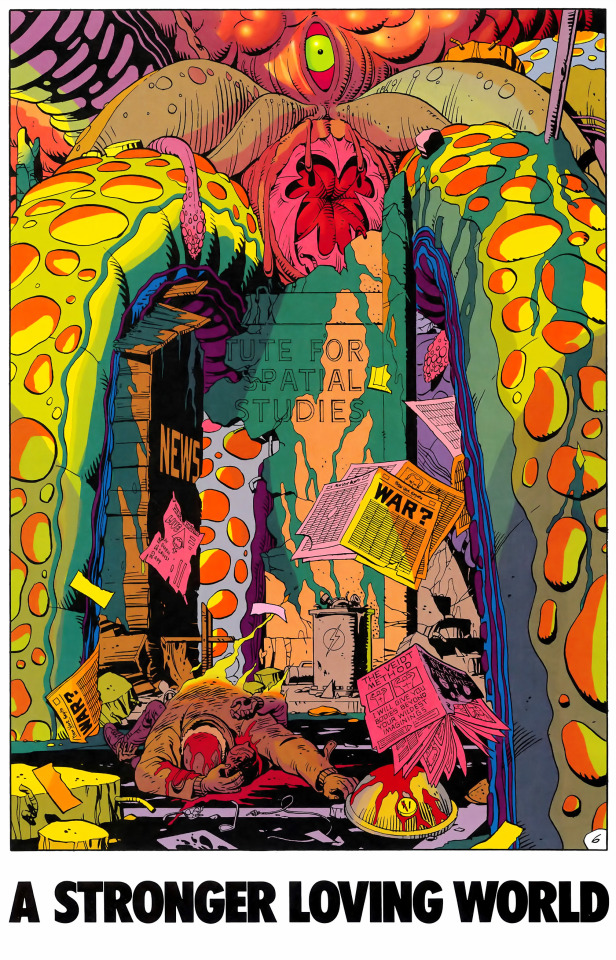
Dr. Manhattan and a heavily distraught Laurie arrive in the city too late as they tour the devastation. After they have seen enough, the two teleport away to the South Pole, to follow a trail of tachyon particles that Dr. Manhattan senses will lead to the source of the disturbance. Before they left, Laurie picks up a gun from the deceased Detective Steven Fine.
At Karnak, Ozymandias continues to detail his plan to Rorschach and a disbelieving Nite-Owl. He explains he cloned the brain of the dead psychic Robert Deschaines and having it augmented and programmed with horrible visions and concepts of aliens, so that the mental transmissions given off at its death would affect anyone around it who managed to survive the initial psychic blast. Thus forcing humanity to cast aside their petty enmities and focus on a common alien enemy. But to ensure this plan to work, Veidt necessarily eliminated anyone involved in his plan. Although Veidt admits he hasn't any ideas what he will do with Rorschach and Nite-Owl.
Manhattan and Laurie soon arrives to Karnak, where Manhattan confront Veidt. Veidt hinders Manhattan with a tachyon generator that interferes with Doctor Manhattan's ability to see the future, and then disintegrates him in an intrinsic field subtractor at the regrettable cost of Veidt's pet Bubastis. This act is witness by Laurie, who then shoots Veidt with Fine's gun. However, Veidt use his newfound, and untried, ability to catch the bullet. After subduing Laurie, Veidt begins to lecture the costumed heroes that their "obvious heroism" is redundant and that their failure to prevent "Earth's salvation" will usher a new era for humanity. But his speech is cut short when to Veidt's surprise, Manhattan restores himself. Before Manhattan could pass judgement on Veidt, the world's smartest man make one last trick by showing everyone news broadcasts of the aftermath of the disaster in New York, which has cost the lives of over two million people, which has prompt an end to hostilities between the U.S. and Soviet Union and calling for peaceful cooperation against Veidt's faked alien threat.
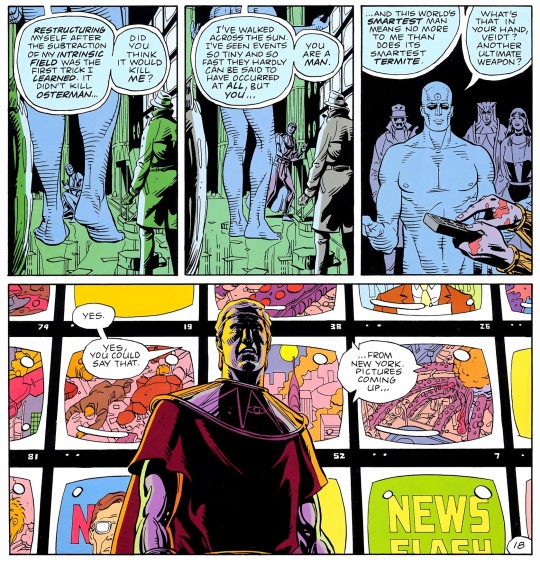
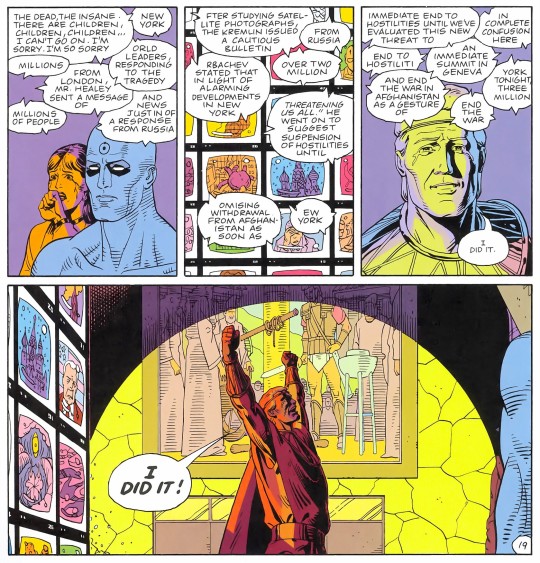
Veidt revels in his victory for bringing Earth into a "utopia" and convinces almost everyone present that exposing the truth would bring a permanent end to world peace. Manhattan, Laurie, and Dan reluctantly agree to concealing Veidt's truth. But Rorschach refuses to compromise with keeping the secret and proceed to leave despite Dan's pleas. Veidt is seemingly unconcerned of Rorschach being a "reliable witness" before retiring to meditate in his ornery and offering Dan and Laurie a stay in his home. Laurie and Dan found a private room to reflect on their decision and they settle down to make love.
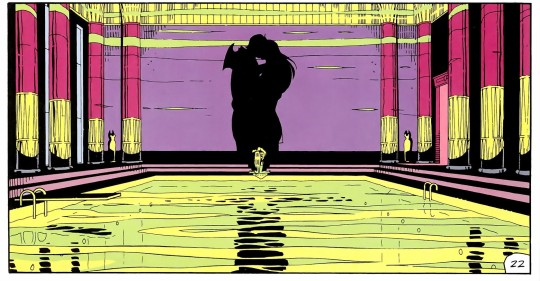
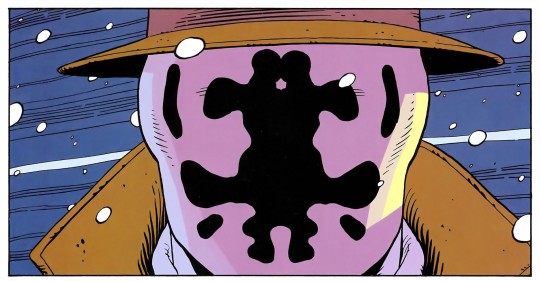
Outside, Rorschach tries to start up his hoverbike but is stop by Manhattan. Rorschach takes off his mask, knowing that Veidt's new utopia is to be protected with the cost of his own life and prompts Manhattan to reluctantly disintegrate him. Manhattan walks back inside the retreat, where he finds Dan and Laurie asleep together and smiles at Laurie's newfound love and happiness and walks out of the room to meet Veidt. The two discuss about Veidt's well-intention reasons for ensuring world peace at the cost of millions of human lives. Veidt is surprise that Manhattan regained interest in human life, to which Manhattan suggests that he may "create some [human life]" in another galaxy that he will be travelling to. But before Manhattan could go, Veidt ask him if his plan worked out in the end. Manhattan smiles and enigmatically replies that "nothing ever ends." Veidt is left totally confuse by Manhattan's words and appears to be in doubt as to whether or not his plan was successful.
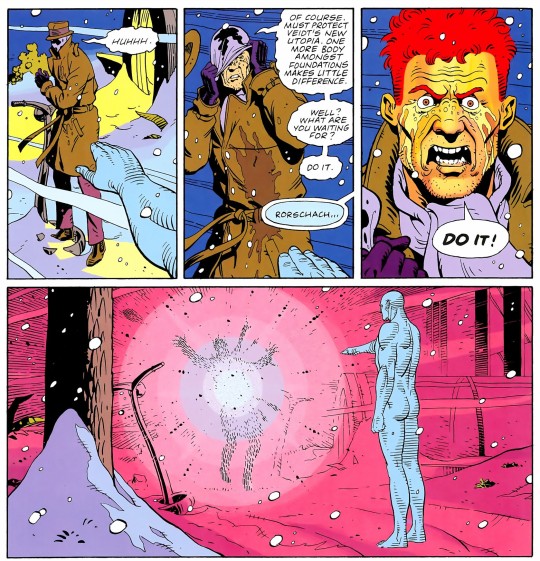
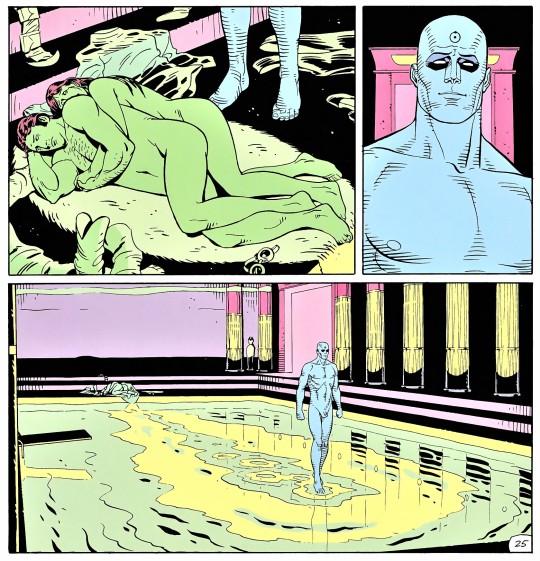
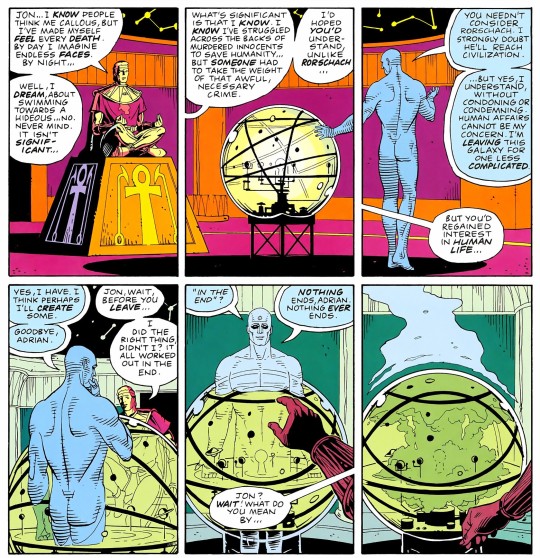
Sometime during Christmas, Laurie and Dan, who have assumed new identities, visit Sally Jupiter. Laurie tells Sally that she knows Edward Blake is her real father. She explains to her mother that she understands the complex relationship between Sally and Blake and that she has comes to terms with that. Laurie and Dan soon leaves while indicating that they would continue to adventure, although Laurie expressed the wish for a better superhero identity, a more protective leather outfit, a mask, and a firearm much like The Comedian.
In New York that which has been recovering from the disaster, the editor at New Frontiersman, Hector Godfrey, complains about having to pull a two-page column about Russia due to the new political climate. He asks his assistant Seymour to find some filler material from the "crank file", a collection of rejected submissions to the paper, to write. Sitting on top of the pile of discarded submissions is Rorschach's journal.
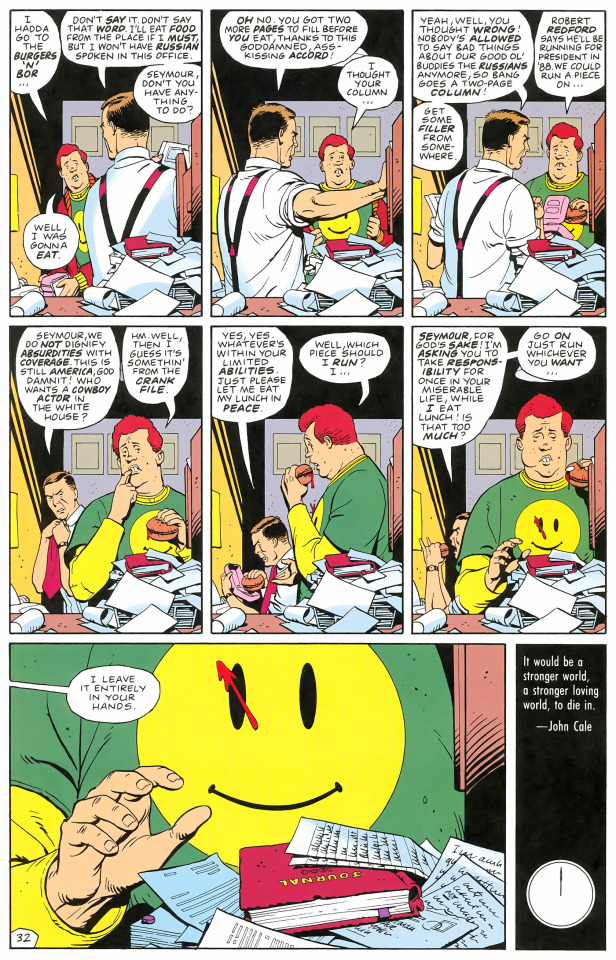

CRITICAL RECEPTION (FROM WIKIPEDIA)
Watchmen was first mentioned publicly in the 1985 Amazing Heroes Preview. When Moore and Gibbons turned in the first issue of their series to DC, Gibbons recalled, "What really clinched it [...] was [writer/artist] Howard Chaykin, who doesn't give praise lightly, and who came up and said, 'Dave what you've done on Watchmen is fuckin' A.'" Speaking in 1986, Moore said, "DC backed us all the way [...] and have been really supportive about even the most graphic excesses". To promote the series, DC Comics released a limited-edition badge ("button") display card set, featuring characters and images from the series. Ten thousand sets of the four badges, including a replica of the blood-stained smiley face badge worn by the Comedian in the story, were released and sold. Mayfair Games introduced a Watchmen module for its DC Heroes Role-playing Game series that was released before the series concluded. The module, which was endorsed by Moore, adds details to the series' backstory by portraying events that occurred in 1966.
Watchmen was published in single-issue form over the course of 1986 and 1987. The limited series was a commercial success, and its sales helped DC Comics briefly overtake its competitor Marvel Comics in the comic book direct market. The series' publishing schedule ran into delays because it was scheduled with three issues completed instead of the six editor Len Wein believed were necessary. Further delays were caused when later issues each took more than a month to complete. One contemporaneous report noted that although DC solicited issue #12 for publication in April 1987, it became apparent "it won't debut until July or August".
After the series concluded, the individual issues were collected and sold in trade paperback form. Along with Frank Miller's 1986 Batman: The Dark Knight Returns miniseries, Watchmen was marketed as a "graphic novel", a term that allowed DC and other publishers to sell similar comic book collections in a way that associated them with novels and dissociated them from comics. As a result of the publicity given to the books like the Watchmen trade in 1987, bookstore and public libraries began to devote special shelves to them. Subsequently, new comics series were commissioned on the basis of reprinting them in a collected form for these markets.
Watchmen received critical praise, both inside and outside of the comics industry. Time magazine, which noted that the series was "by common assent the best of breed" of the new wave of comics published at the time, praised Watchmen as "a superlative feat of imagination, combining sci-fi, political satire, knowing evocations of comics past and bold reworkings of current graphic formats into a dystopian mystery story". In 1988, Watchmen received a Hugo Award in the Other Forms category.
OWNERSHIP DISPUTES (FROM WIKIPEDIA)
Disagreements about the ownership of the story ultimately led Moore to sever ties with DC Comics. Not wanting to work under a work for hire arrangement, Moore and Gibbons had a reversion clause in their contract for Watchmen. Speaking at the 1985 San Diego Comic-Con, Moore said: "The way it works, if I understand it, is that DC owns it for the time they're publishing it, and then it reverts to Dave and me, so we can make all the money from the Slurpee cups." For Watchmen, Moore and Gibbons received eight percent of the series' earnings. Moore explained in 1986 that his understanding was that when "DC have not used the characters for a year, they're ours." Both Moore and Gibbons said DC paid them "a substantial amount of money" to retain the rights. Moore added, "So basically they're not ours, but if DC is working with the characters in our interests then they might as well be. On the other hand, if the characters have outlived their natural life span and DC doesn't want to do anything with them, then after a year we've got them and we can do what we want with them, which I'm perfectly happy with."
Moore said he left DC in 1989 due to the language in his contracts for Watchmen and his V for Vendetta series with artist David Lloyd. Moore felt the reversion clauses were ultimately meaningless because DC did not intend to let the publications go out of print. He told The New York Times in 2006, "I said, 'Fair enough,' [...] 'You have managed to successfully swindle me, and so I will never work for you again.'" In 2000, Moore publicly distanced himself from DC's plans for a 15th anniversary Watchmen hardcover release as well as a proposed line of action figures from DC Direct. While DC wanted to mend its relationship with the writer, Moore felt the company was not treating him fairly in regards to his America's Best Comics imprint (launched under the WildStorm comic imprint, which was bought by DC in 1998; Moore was promised no direct interference by DC as part of the arrangement). Moore added, "As far as I'm concerned, the 15th anniversary of Watchmen is purely a 15th Anniversary of when DC managed to take the Watchmen property from me and Dave [Gibbons]." Soon afterward, DC Direct cancelled the Watchmen action-figure line, despite the company having displayed prototypes at the 2000 San Diego Comic-Con International.
LEGACY (FROM WIKIPEDIA)
A critical and commercial success, Watchmen is highly regarded in the comics industry and is frequently considered by several critics and reviewers as comics' greatest series and graphic novel. In time, the series has also become one of the best-selling graphic novels ever published. Watchmen was the only graphic novel to appear on Time's 2005 "All-Time 100 Greatest Novels" list, where Time critic Lev Grossman described the story as "a heart-pounding, heartbreaking read and a watershed in the evolution of a young medium." It later appeared on Time's 2009 "Top 10 Graphic Novels" list, where Grossman further praised Watchmen, proclaiming "It’s way beyond cliché at this point to call Watchmen the greatest superhero comic ever written-slash-drawn. But it’s true." In 2008, Entertainment Weekly placed Watchmen at number 13 on its list of the best 50 novels printed in the last 25 years, describing it as "The greatest superhero story ever told and proof that comics are capable of smart, emotionally resonant narratives worthy of the label 'literature'." The Comics Journal, however, ranked Watchmen at number 91 on its list of the Top 100 English-language comics of the 20th century.
In Art of the Comic Book: An Aesthetic History, Robert Harvey wrote that, with Watchmen, Moore and Gibbons "had demonstrated as never before the capacity of the [comic book] medium to tell a sophisticated story that could be engineered only in comics". In his review of the Absolute Edition of the collection, Dave Itzkoff of The New York Times wrote that the dark legacy of Watchmen, "one that Moore almost certainly never intended, whose DNA is encoded in the increasingly black inks and bleak storylines that have become the essential elements of the contemporary superhero comic book," is "a domain he has largely ceded to writers and artists who share his fascination with brutality but not his interest in its consequences, his eagerness to tear down old boundaries but not his drive to find new ones." Alan Moore himself said his intentions with works like Marvelman and Watchmen were to liberate comics and open them up to new and fresh ideas, thus creating more diversity in the comics world by showing the industry what could be done with already existing concepts. Instead it had the opposite effect, causing the superhero comic to end up stuck in a "depressive ghetto of grimness and psychosis". In 2009, Lydia Millet of The Wall Street Journal contested that Watchmen was worthy of such acclaim, and wrote that while the series' "vividly drawn panels, moody colors and lush imagery make its popularity well-deserved, if disproportionate", that "it's simply bizarre to assert that, as an illustrated literary narrative, it rivals in artistic merit, say, masterpieces like Chris Ware's 'Acme Novelty Library' or almost any part of the witty and brilliant work of Edward Gorey".
Watchmen was one of the two comic books, alongside Batman: The Dark Knight Returns, that inspired designer Vincent Connare when he created the Comic Sans font.
In 2009, Brain Scan Studios released the parody Watchmensch, a comic in which writer Rich Johnston chronicled "the debate surrounding Watchmen, the original contracts, the current legal suits over the Fox contract".
In September 2016, Hasslein Books published Watching Time: The Unauthorized Watchmen Chronology, by author Rich Handley. The book provides a detailed history of the Watchmen franchise.
In December 2017, DC Entertainment published Watchmen: Annotated, a fully annotated black-and-white edition of the graphic novel, edited, with an introduction and notes by Leslie S. Klinger (who previously annotated Neil Gaiman's The Sandman for DC). The edition contains extensive materials from Alan Moore's original scripts and was written with the full collaboration of Dave Gibbons.
THE FILM
There are three versions of the Watchmen movie. The theatrical (that I watched several time at cinemas, including IMAX), a director’s cut (includes an extra half hour of movie) and the Ultimate Cut, which includes all the Black Freighter scenes.
I would recommend the theatrical version. I recently watched the ultimate version and the Black Freighter scenes do not work with the movie and also do not work with its altered ending. Hollis Mason’s death scene also feels even more disconnected to the story.
But even the theatrical version... I would say... I do not recommend you to watch it if you haven’t read the novel. The movie is a piece of beauty, visually, but the script feels a lot like they tried very hard to keep the original dialogues, and every time they change something you notice, because something feels out of place (even if you are watching it with fresh eyes).
REVIEW
What else can I add?
As a fan, I find it uneasy that only Gibbons can enjoy the credit for this story in all the adaptations, as Moore does not want to be mentioned in any of those (instead, they always say “co-created by Dave Gibbons”). It makes me feel dirty for buying the book a couple of times, and watching the movies (also V for Vendetta).
But beyond that, this is a piece of art, a very sophisticated piece of art. It’s what comics should aspire to be. Not every comic-book should... but I would love seeing something like this more often.
The series was made with great level of detail. To the point where you can spend minutes on pages or panels, finding things. In this last issue, the first look at New York, after the peace accord, is a whole new world full of details that tell you a story. This is why Watchmen is the perfect graphic novel, and has so much problem being adapted to other mediums or even having prequels and sequels. It was designed in a way that makes sense in these 12 issues of visual entertainment, where writing and art tell a complete story, but wouldn’t be the same if you had a novelization of it.
It was made for comic-books. You could do an adaptation to film with the same level of detail, but you wouldn’t be able to enjoy it, pausing to find all the details in every frame. Instead, they would have to find a new way of adapting this highly detailed and three-dimensional world.
I recommend buying the “Watchmen Annotated” edition as well, as a supplementary book to the regular one (or absolute, depending which version you have).
I give Watchmen a score of 10, and you should read it at least twice before you die.
#alan moore#dave gibbons#john higgins#dc comics#comics#review#1987#modern age#doctor manhattan#rorschach#nite owl#silk spectre#ozymandias#bubastis#world war iii#new frontiersmen#vertigo comics
9 notes
·
View notes
Note
You know, it wouldn’t surprise me if even Diana’s mother hated Bruce, lol
Since 1986 Batso’s been designed as the ultimate fanboy dream. I said “fanboy”, not girl.
Although he gets all the girls in comics and movies, I doubt his attitude would appeal many women in real life.
Yeah, there’s the money thingy (money being the most powerful aphrodisiac), but beyond that, he’s one of the most sexist characters ever.
Not only women, but he treats everybody like crap: friends and colleagues, even lovers.
Imagine him giving Hippolyta the “scowling treatment”? The Queen would punch him in half a second and hung him to be eaten by the eagles. Or boasting about his warrior abilities in front of her: he trained for about what? 20 years? At best. The least trained of the Amazons trained for millennia. He’ll be a pin cushion in a heartbeat.
Smarty pants? Yeah. I don’t give a coin for his life after he tells Diana’s mother:
“I am right, you are wrong”
Like he does with everybody.
Can you figure him doing the disappearing trick in front of them? Hunters used to track the most elusive animals, even in the dark, by the grace of the goddess Artemis, will caught him in a few minutes.
If he were the first man the Amazons see in a thousand years, the women would think the Patriarch World is worse than ever. Steve Trevor is not much, but he’s still better than Batso.
Thank Goodness they also know the likes of Superman and J’onn.
Of course, writers would tell the Amazons were in awe at his mere presence, captivated by his badboyish charm and wisdom and impressed by his bat-ish Halloween costume.
Truth is they would kick him out of the Island, tied to a tree trunk. A few of them would’ve liked to sacrifice him to the goddess Athena, but they concluded he isn’t even worthy of that.
8 notes
·
View notes
Link
January 16, 1986 12:00PM ET
Double agents selling secrets to foreign governments; defectors running amok in the streets of Washington; allies betraying allies — these days spies are out of the shadows and on the spot. Yet espionage isn’t what it once was, and at least one Cold War vet fondly remembers overthrowing unfriendly governments, planning assassinations and performing dirty tricks. Most of all, retired CIA officer Miles Copeland (whose brood of rock & roll overachievers includes oldest son Miles Copeland III, manager of the Police and solo Sting; Ian, founder of the music booking agency FBI; and youngest son Stewart, drummer first for Curved Air and later for the Police) yearns for the good old days when secret agents kept their secrets secret — from the government and especially from the press.
Born in Birmingham, Alabama, Copeland joined the U.S. Army in 1940. Assigned to the Counter-Intelligence Corps (CIC), he transferred in 1942 to the new Office of Strategic Services (OSS), the first U.S. secret intelligence agency. After the war, Copeland was station chief in Damascus, “putting Syria,” as he recalls, “on the path to democracy by starting a military dictatorship.” For this achievement, he was awarded a presidential citation. Copeland became a member of the Central Intelligence Agency when it was founded in 1947; he was appointed chief of the agency’s Political Action Staff, the dirty-tricks department, in 1950. “Nobody,” he says, “knows more about changing governments, by force or otherwise, than me.”
Copeland left government service in 1957 to form his own “private CIA,” which he claims became the largest private security service operating in Africa and the Middle East. Today the seventy-two-year-old Copeland and his wife, Lorraine, a well-known British archaeologist, live in a stone cottage in the tranquil hamlet of Aston Rowant, near Oxford, in England.
The White House has given the CIA part of the Job of handling terrorism. What do you think they will do that is different from what has already been done? You know, you’re opening a real can of worms here. The difference between the CIA’s counterterrorist experts and this new kind that’s been proliferating all over the place is that the CIA has operators who know the terrorists, who’ve actually talked to a few, who’ve even lived with them, or who, like myself, have actually been terrorists. We understand the enemy, while these instant experts who’ve been advising the White House have never in their lives laid eyes on a terrorist, and they think of them as common criminals. Maybe they are, and maybe they aren’t, but where these recent “experts” are wrong is that they assume they are criminals simply because they are judging them as though they are Americans, brought up on American ideas of what’s right and what’s wrong. They are making moral judgments that aren’t relevant to the situation. What may be effective in combating crime is not likely to be effective in dealing with wrong doers who in their own eyes, whether rightly or wrongly, think they are engaged in some noble cause. The Pentagon wants to kill them; the CIA wants to win them over.
Who’s winning? It’s not a matter of winning. Just different viewpoints. The president of the United States has got to say what is necessary to keep himself in office. We have a domestic foreign policy and a foreign foreign policy. The domestic foreign policy, which is the more important one, is what he has to do to make the American public think he’s doing the right thing. Whether it’s the right thing or not doesn’t matter. The American people have to think he’s doing the right thing because we have a democratic society. Now, the American people were highly indignant about what happened in Beirut [the hijacking of TWA flight 847 in June 1985]. They wanted to do something. They wanted to punish the people without regard to the consequences. The president had to say things to them, make threats, to show the American people that, by God, we were doing something. But the professionals inside the government were worried about the consequences of this. Because what it takes to please the American people is not what it takes to please a lot of people who did not grow up in the American culture but grew up in cultures quite different from our own. We’ve got most of the world against us at the moment. When we drag out our gunboats, bomb villages and kill a lot of women and children — a lot more than the terrorists kill — we turn the world against us. And the American people don’t care. They don’t give a damn. But those people whose job it is to look after the interests of the U.S. government abroad, they’ve got to care. They have to think of the consequences of everything we do. And they know the consequences of dragging out the gunboats are absolutely the wrong ones. In fact, these are the consequences the terrorists created acts of terrorism in order to provoke. That’s the purpose of terrorism, not to kill, maim or destroy, but to terrorize, to frighten, to anger, to provoke irrational responses. Terrorism gains more from the responses than it gains from the actions themselves.
So how do you deal with it? You’ve got to know who they are. You’ve got to know their reasons for doing it. And you’ve got to manipulate them in one way or another. We have to somehow come to grips with the problem. The Israelis went in to Lebanon and killed tens of thousands of people. They say, “That’s exaggerating, we didn’t kill but 5,000 people.” Okay, let’s say they killed only 2,000 people, which is a very modest estimate. But they destroyed Lebanon. They then set up groups against each other, made chaos ten times worse than it already was. Instead of helping the Shiites — the Shiites welcomed the Israelis in — we, the United States, gave a billion dollars to the Israelis. One billion we gave because it costs a lot of money to destroy someone else’s country. We gave peanuts — Red Cross supplies — to the Shiites. What we should have done is gone in there and said to the Shiites: “Look, a lot of injustice has been done. We’re going to put your orange groves back and put you back commercially. . . . “
Is that your answer for potential terrorists? Give them lots of aid to keep them sweet? No. Let’s get back to the reason these guys are terrorists. They’re terrorists because their orange groves have been destroyed and they’ve got nothing to do. They can’t even get to their farms because the Israelis have declared them out of bounds and destroyed a lot of them. Now, the CIA’s job is to explain all of this to our government. That’s the main job of the CIA — to go to the White House and explain to the president that the only reason these terrorists are terrorists is because of the way they’ve been treated, and they’ve got nothing else to do. In fact, I’ll tell you quite frankly, if people came into Alabama, my home state, and destroyed my farms and kicked me around and kicked my children around, I’m going to become a terrorist, just as the French became terrorists under the Germans in World War II. It’s understandable. The CIA understood this and understood it very well and explained it to the president. But we had pressures from Congress. The members of Congress don’t give a damn about foreign affairs. They give a damn about their next election. They have to do what makes them popular enough with their constituents to get reelected. And their constituency cares about one place in this world, and that’s the United States.
You have told me what we should have done. What should we do to combat terrorism now that the damage has been done? Well, most terrorists in the world are coming down to two categories. The first kind are people such as the Palestinians, who’ve had — listen, I’ve known this one family for the past forty years. The guy has polio, he’s crippled. He has some teenage kids who are nice kids, nice family. The Israelis showed up at six o’clock in the evening and said: “Everybody out! Everybody out!” They all got out, and the Israelis razed his house. He says: “I haven’t done a damn thing! I’m just looking after my orange groves!” They said, “You had a terrorist in your house six months ago.” First place, he said he hadn’t, and I believe he was telling the truth. But the Israelis had no good reason to believe he wasn’t — no name, no information at all. Now this is information that our embassy reported. This is official, not something I heard from the PLO information office. Now those two teenage kids stood there and watched their family being destroyed and their mother kicked downstairs when she refused to leave the house. Can you imagine their not becoming terrorists? They don’t have an air force or artillery. I had a Shiite ask me: “You say we shouldn’t use terrorism. What should we use?” Well, you shouldn’t use anything, we might say. You should make peace with Israel. Make peace with Israel? They’ve just destroyed my land! I have nothing! My house is flattened! The whole village is destroyed! This isn’t just the Shiites talking. Our own embassy says this. You know something that very few people know, and I suspect you ought to leave all this out, but the fact is, in the American foreign service, there are a lot of patriots. You’ve never seen such patriots in your life. They all fight for American policy, right or wrong. Central America, Vietnam, wherever, except in the Middle East. The whole career service in the Middle East spends all its time fighting its own government. Anyone who doubts that can use the Freedom of Information Act to get the cables, all of them pleading with our own government to stop this support of Israel to that point. I don’t mean stop supporting Israel, but stop the behavior of Israel, which is making them hated. And we are backing them against these people they’ve kicked around. And how did the Israelis get in power? Terrorism. You’d think they’d know something about terrorism since the heads of their government have been terrorists themselves. In fact, Israel wouldn’t be there if it hadn’t been for their effective terrorists. But they know nothing about terrorism. A friend of mine in Mossad [the Israeli intelligence agency] said: “Terrorism is not going to destroy Israel, but our counterterrorism might, because it costs us a million dollars a day. It might drive us into bankruptcy.”
So what’s the answer to terrorism? Like I was saying, we have to find the reason these people are terrorists. The job of the CIA is to report why they are terrorists. Now I said there are two categories. The first, people who have been deprived and been ruined. The second category is this: A lot of these guys have found a way of life. They’re like gunslingers in the Old West. They drive Mercedes. There are professional terrorists now. It’s a profitable business. Maybe they were criminals originally, criminally inclined, but now they have political motivations to justify themselves. You’re not going to find them. Many of them are in Paris, and the French police don’t give a damn. The fact is that we are fighting a “proxy war” right now in which Soviet proxies face our proxies. Today’s war, between us and the Soviets, is a mosaic of regional wars. The Soviet policy is one of denial, not to gain territory for themselves but to deny it to us, to deprive us of the raw materials from Africa — cobalt, magnesium, chromium — that we have to have for a highly technological society like ours.
Are you saying the Soviets are behind terrorism? No, they exploit the troubles. Most of the terrorism in the world today the Soviets do not instigate. They may train key people to go in and stir things up, but that’s as far as they go. The Soviets are delighted when we draw up a gunboat in the Beirut harbor. They love this. It makes people hate us. The thing we should have done about the TWA hijacking in Beirut was get the damn thing over with right away as the CIA advised.
And how would we have done that? Let the Shiites loose. Forget it. We’ve lost this one.
Wouldn’t giving in like that encourage more terrorism? No. What encourages them is to get all that prime time on television. They wanted the publicity they got. And they wanted us to look like jackasses, which they succeeded in doing. In a war, you lose battles now and then. The best thing to do is cut your losses and get the hell out. They were hoping we’d drag it out.
You think the media was out of control? The media is always out of control. It’s not supposed to be under control. That’s what we have to live with in a free society. You can’t prevent the media from doing what it wants to do. But you can prevent the media from getting the information in the first place, by having rules for those who have the secrets not to release them to the media.
All right, how would the rules have worked in Beirut? How could you have prevented the madness that ensued? You know, if a plane lands in Turkey right now, the minute they establish there are hijackers on it, you know what happens? Nothing. They cut off all communications. “We want you to release so-and-so.” Silence. They just sit there and rot as far as the Turks are concerned. So there’s no news whatsoever. It’s not unethical to give the press false information. We do have a kind of adversary relationship with the press. There’s nothing we should try to do to shut them up, but it is absolutely permissible to tell the press whatever is in the interests of the American people to have the press know or think. And they can use it any way they want to. They can be suspicious, as they should be. A good pressman is suspicious of what anyone tells him.
How does your vision of the CIA fit Western democracy? [Laughter.]
Come on, what are Miles Copeland’s principles of democracy? Let me tell you about democracy. First place, I remember Syria. We decided we were going to bring democracy to Syria. So we got a translator in Arabic, and we got signs. We were going to have an election. This is 1946, ’47. The signs say, Get Out And Vote For The Candidate of Your Choice. We had people coming in the embassy and saying, “Look, these signs are no good — they don’t tell us who the candidate of our choice is.” In the United States, if we had true democracy, it would be a good thing. But true democracy is impossible now because of the fact that the general population cannot possibly keep themselves well enough informed to decide on issues except on a very parochial basis. The average person, the best he can do is something he’s not allowed to do — that’s to vote for a man because he’s known to be honest and competent. But now a candidate has to tell you what his issues are and get elected on that basis. We have to sell the idea to the American public that there are many things about foreign policy the American people simply cannot understand, because foreign policy requires, above all else, judging people according to their own standards. The emphasis should be in choosing people we trust. Where the CIA can work as an institution in a democratic government is, we have to set up criteria where nobody can get into the CIA unless he’s honest and patriotic. And I think they’ve succeeded at that. The guys in the CIA are the most strait-laced people you ever saw.
Who gets your highest marks as CIA director? I’d have to name two people, and for totally different reasons. I think George Bush was the best. He came in knowing he didn’t know a damn thing about the CIA, but he did know how to judge people whose opinions he could trust, and he listened to them.
Who is second? Dick Helms. Helms lied to a congressional committee. That’s one of his fortunate traits, that he’s willing to lie to a congressional committee. William Colby didn’t have the guts to do this. Lacking patriotism, he did not lie to a committee.
Wait a minute — lacking patriotism? Absolutely. Why should he tell a group things he knew would leak to the newspapers? He should have lied to them. If he were really a patriotic American, he wouldn’t have thought of telling them the truth.
And Helms gets high marks for perjury? With me and with everyone who has ever been a career officer in the government. Absolutely. You can call it perjury if you like, and maybe it was, but he should have been willing to go to jail for it.
It’s okay to lie under oath if you’re in the CIA? I said nothing of the sort. If what you know means that telling the truth is going to damage the national interest, it is your obligation. . . .
Who decides the national interest? Do you want me to give you a hard time or do you want an answer?
Both. Okay, I’ll give you an answer: The CIA is set up so that it’s impossible for a person as an individual to arrogate to himself the right to lie to a congressional committee or to anyone else. But what he can or cannot say is clearly specified from the day he is sworn in. He can lie to people who are not his bosses, who do not have security clearances. Most congressmen do not have security clearances. When Senator Frank Church asked me something, and he said, “Will you take an oath,” I said, “Senator, I’ll take the oath, and I wouldn’t think of telling you the truth.” Personally, I like Colby very much. He’s a very fine man, but he’s just the wrong kind of guy to be head of the CIA. He’s a good guy.
You’ve got to be a bad guy to head the CIA? You have to be prepared, as a good soldier does. A good soldier could be religious and have read the Bible, but he’s got to go out and kill people. The CIA has to have a separate set of morals. In that sense, you have to be amoral.
Is it true you were once asked by your CIA bosses to kill President Nasser of Egypt? My old boss, Frank Wisner, passed on to me orders that I was to “explore the possibility” of assassinating Gamal Nasser. Poor Wiz didn’t like doing even that. But the order came straight from the White House. Anthony Eden, who was Britain’s foreign minister at the time, believed the world would be a happier place without Nasser in it, and the belief grew to enormous proportions after the Suez fiasco. The head of British intelligence, who had a somewhat wry sense of humor, used to say that if either his boys or ours didn’t assassinate Nasser “professionally,” Eden was likely to do it himself “amateurishly,” and the results would be “messy.” Eden’s attitude was “At least we should look into it.” He said as much to his opposite number in Washington, John Foster Dulles, and Dulles discussed it with President Eisenhower, who said, in effect, “Anything to keep Tony quiet.” The order was passed down, from the president to the secretary of state to the director of the CIA — Foster’s brother, Allen — to Frank Wisner to Kermit Roosevelt to me. I was to visit Nasser, have coffee with him, say, “That’s an interesting vase you have over there in the corner,” and when he turned his head to look, make the motion of slipping a cyanide pill into his cup just to see if he would catch me at it.
Did you do it? Sort of, and I didn’t have to use the “look over there” trick. Nasser kept looking the other way out of sheer boredom at what I had to say. Just sitting there with Nasser, rehearsing in my mind just how I would go about sneaking something into his lemonade or coffee, I saw how easy it would have been-theoretically, that is. When I got back from the Nasser experiment, I went into the whole question of assassination, from the philosophy behind it to all the ways of doing it.
Philosophy of assassination? Very important. All these post-Watergate liberals forget that assassination was once a healthy alternative to war. There is only one justification for assassination: to save lives, lots of lives. One life to save many. But as for a weapon of strategy, that’s a different story.
What is the justification? The rationalization by which the so-called war of dirty tricks is justified is that it takes the place of a real war in which millions may be killed. Given such a justification, anything goes. For example, you can sometimes gain points in the war of dirty tricks by killing an expendable person on your own side and blaming it on the other. But that kind of nonsense is talked about only in meetings where “contingencies” are being considered. In those meetings, it is permissible to suggest literally anything.
One CIA target was President Patrice Lumumba of the Congo, in the summer of 1960. . . . Well, now, I’ll tell you a brief story to illustrate what a great farce that was. The CIA station chief in the Congo at the time, who I knew very well, was a very sober, conservative fellow who harbored the ambition to get into the State Department. Since he was really a CIA man, his State Department job was only a cover — and at a lower grade than his CIA job called for, to the disgrace of his wife. So his main worry was his wife, who was complaining that she wasn’t invited to parties and wasn’t seated high enough above the salt at dinners. And he was wondering how he got this lousy job in the Congo. One day he was contemplating the sadness of his lot when a message arrived from Washington. It had a code word which means this is something you take seriously because this comes from the White House. Ordinarily, when you get an order from headquarters you never obey it the first time because you’re not sure they mean it. It might be some guy telling you to do something to get himself off the hook, being on record as having ordered it. So you always wait until the second time. But if there’s a White House code word, you’d better take it seriously. The message from the White House said he was to assassinate Lumumba — to explore means to terminate with extreme prejudice. He couldn’t believe his eyes. The last thing he wanted to do was assassinate anyone, except perhaps his wife! But this thing said he had to go kill Lumumba, and he hadn’t the faintest idea how to go about it. Well, then another cable came in, saying somebody was coming out from the scientific section. And up showed this weird little Dr. Strangelove type. So not only does this guy have an order from the White House, he’s also got on hand this creep who was going to show him how to do it! Well, the station chief just blew his top, said, “The hell with this,” and told Dr. Strangelove to get the hell out.
What else did you get up to in the CIA? Well, I got my foot in the door in the psychopharmacological department by virtue of my interest in assassination. There are two categories: those which are made to look like natural deaths and those which serve their purpose only if they are known to be assassinations. For the first kind, there is a variety of methods, most of them involving poison. Somehow you introduce into the body of your victim two separate substances, at different times, each of which is harmless by itself but which becomes poisonous when mixed with the other. You wouldn’t believe what those weirdos come up with! The congressional subcommittee which went into this sort of thing got only the barest glimpse.
What did they miss? You can kill a man by putting a certain substance on a letter you send to him which gets into his system simply through his holding the letter in his fingers. You can make him allergic to almost anything — alcohol, aspirin tablets, even coffee or tea — that if he takes even a small quantity of it he will drop over dead. You can program a pair of dogs — even his own dogs — to savage him to death upon a given signal. You can do any number of imaginable and unimaginable things. But you don’t have to kill him; you can just make a fool out of him.
For example? You can slip an LSD pill into his lemonade as he is about to make a speech or have an electric fan blow “distress gas” onto him, or you can doctor his notes so that simply by holding them in his hands he will absorb enough hallucinatory materials to make him think he is God. One of [Indonesian president] Sukarno’s best, most electrifying speeches, I understand, was made after one of his assistants, a CIA agent, doctored his shaving lotion. The agent simply forgot that Sukarno’s wildest ramblings were made when he was cold sober and that a hallucinogen could only make for an improvement!
What do you think of today’s CIA? The organization itself is great, and Mr. Casey is tops, but the government won’t let it move, and the press is intent on preventing any secret operations it might try to run. As you know, unlike The New York Times, Victor Marchetti and Philip Agee, my complaint has been that the CIA isn’t overthrowing enough anti-American governments or assassinating enough anti-American leaders, but I guess I’m getting old. What’s keeping the agency inactive is Congress and disinformed public opinion. With modern communications being what they are, we’re supposed to be the best informed people in history, but we’re not. We’re the most informed, which is hardly the same thing.
You seem to take an active interest in American politics. Do your sons share your interest? It’s my impression my oldest son, Miles, has actually contributed to Republican congressional campaigns, but I’m not all that sure. That’s one area of my son’s activities he doesn’t confide in other members of the family about. [Laughs] My son Miles — he wants everything everybody says about him these days to be cleared in advance.
Does Miles have anyone in mind for the presidency in 1988? I know Miles has his eye on Congressman Jack Kemp [Republican — New York]. I think that’s his candidate, but I don’t know. [Miles Copeland III denies that he supports Jack Kemp or any other Republican or Democratic candidate for Congress or for the presidency.] He’s always planning several years ahead. Miles is pretty secretive about his affairs. He should have been in the CIA instead of me. Yeah, I’m “blah blah blah,” and he’s “hush hush.” I’m not sure he’s thought through all the implications of the power he’s got.
What do you mean? The next time you go to a Police concert — say, one like that in Shea Stadium, with 70,000 young minds open to whatever the Police decide to put into them — you can answer that question for yourself.
#cia#terrorism#cia assassination#imperialism#cold war#israel lebanon war#lebanon#george h w bush#the police#miles copeland#egypt#gamal nasser#PLO#israeli colonialism
7 notes
·
View notes
Text
Episode Review- The Real Ghostbusters: Ghosts R Us

Following the success of the 1984 hit, the animated spin-off show, The Real Ghostbusters, was produced by Columbia Pictures Television, DiC Entertainment and Coca-Cola Telecomunications, and it ran from 1986 to 1991. You might be wondering why the show wasn’t simply called Ghostbusters, like the movie, and instead called itself The Real Ghostbusters. Well, that’s because of a dispute they were having with Filmation. Around the time Columbia Pictures they were creating the animated spin-off, Filmmation decided to create their own animated show, this one a revamp of their earlier live-action show, The Ghost Busters, which ran from 1975 to 1976. But instead of calling this animated revamp of theirs the same name as the live-action show, they decided to drop the ‘the’ and make ‘Ghost Busters’ into one word instead of two. Pretty obvious what they were trying to do there. To be fair, of course, the legal deal that was struck up between the two studios that allowed the 1984 movie to use the title ‘Ghostbusters’ instead of some other tile like ‘Ghostbreakers’ or ‘Ghostmashers,’ stated both companies could use the title of ‘Ghostbusters’ in an animated show. So technically speaking, Filmmation did have the rights to do this, even though it was clear they were trying to indirectly cash in on the success of the movie. So Columbia Pictures, in order to differentiate their show from Filmmations’ version, and possibly to make a jab at them in the process, added ‘The Real’ to their show’s title. Although, it does make a bit of sense in the show itself. In the show’s universe, the animated versions of Egon, Ray, Peter, Winston, etc. are all the genuine articles, and the movie that preceded the cartoon was actually based on their experiences. In one episode, I believe they even go to Grauman's Chinese Theater in Hollywood as guests-of-honor for the movie’s premiere.
So, with all of that out of the way, on to the show itself, starting with the first episode, Ghosts R Us.
The episode starts with the Ghostbusters on their way to respond to a ghost disturbance at a local chocolate factory called Conrad’s. Wasn’t aware there was a chocolate factory in New York City, but I think this takes place in a parallel reality to ours, so I guess I can accept this. Turns out, the ghosts terrorizing the multitude of candy makers are a family unit- an irritable father, a doting mother and their giant baby, who might remind you strongly of Baby Huey. When the Ghosbusters arrive on the scene, we get treated to a bit of slapstick, with the Ghost Family pelting them with globs of melted chocolate. At one point, Slimer, who now lives with the Ghostbusters and decided to tag along on this call, gets to stuff his face with the multitude of chocolate being ejected from the factory’s smokestacks, and both Ray and Winston get a face full of chocolate goo. Eventually, they manage to capture the Ghost Family in a single trap. Despite the huge chocolaty mess that resulted from the bust, the owner of Conrad’s thanks the Ghostbusters, rewarding them with a sizable pile giant heart-shaped boxes of the company’s finest chocolates. And when I say giant boxes, I MEAN giant boxes. They’re as big as a coffee table. That’s a lot of chocolate.
Upon returning to the Firehouse, the guys attempt to give the boxes of chocolate to Janine as a present. But, as one would expect, Slimer, bottomless pit that he is, had already helped himself to the chocolate during the ride back, so all Janine ended up getting were empty boxes. Peter is particularly irritated by this latest stunt, and he angrily states that Slimer is on notice, and if he messes up just one more time, then he’s history. With that, the Ghostbusters all head off to bed, with Winston announcing that it had been a very long day for them. But first, Ray heads down to the basement to transfer the Ghost Family they caught to the Containment Unit.
During the night, Slimer wakes up from a dream about food. Because apparently ghosts can sleep. And dream. Anyway, he decides he wants a midnight snack and proceeds down to the kitchen to raid the fridge. While he’s down there, Winston gets woken up by the noise downstairs and he heads down to investigate. Slimer, trying to avoid getting caught, tries hiding out in the basement. Eventually, Winston returns to bed, deciding that he probably imagined the noise. Slimer is relived he wasn’t caught, and slides down the side of the basement wall with a huge sigh. But in the process, he accidentally hits the switch for the Containment Unit, which turns it off. When Slimer realizes what he did, he goes into panic mode, remembering what Peter had said would happen if he messed up again. He hurriedly pulls the switch back into the ‘on’ position to try and rectify the situation. Deciding the crisis was averted, especially since none of the Ghostbusters heard the alarm going off, he returns to bed. Unfortunately, it turns out that the recently captured Ghost Family had managed to escape the Containment Unit during that brief window. Upon making good on their escape, they begin to plot to get their revenge on the Ghostbusters by putting them out of business.
The Ghost Family’s plan soon becomes apparent. Ghost Baby basically shows up at a particular location to scare some people. But before the Ghostbusters can arrive, Mom and Pop Ghost appear on the scene disguised as humans and pretend to vanquish Ghost Baby. It’s an admittedly clever con, and eventually, the people of NYC are trusting the new ghost exterminators called ‘Ghosts R Us’ instead of the Ghostbusters. Though the plan only seems to work because, for some reason, there aren’t currently any OTHER ghosts crawling out of the woodwork at the moment. Eventually, Janine, for reasons not fully explained, checked the Containment Unit and noticed that three ghosts were missing. She reports this to the guys, who instantly figure out what’s really going on, and also realize Slimer accidentally caused the Ghost Family to escape.
Before anyone can come up with a way to punish him, the Ghost Family calls them up pretending to be some frightened humans, telling them there’s a ghost sighting at an old toy factory on the outskirts of town. The Ghostbusters head out to the toy factory, knowing that the Ghost Family will probably be there.
Apparently, this toy factory trap is the final stage in the Ghost Family’s revenge plot. Pop Ghost states there’s a ghost called Turlock who haunts in this old factory, and he goes in to try and get Turlock to take out the Ghostbusters for them, Unfortunately for him, Turlock seems to have vacated the premises, and an even stronger ghost than Turlock resides there now. And this new ghost is NOT HAPPY about being woken up by Pop Ghost. The new ghost proceeds to possess a bunch of discarded toys, forming a giant toy monster, complete with a creepy Jack-in-the-Box for a body and an evil Cymbal Monkey for a head, and the Toy Monster starts to chase after the Ghost Family through the busy city streets. In order to put a stop to all of this, the Ghostbusters split off into two groups, with Peter and Winston remaining in the Ecto-1 to follow the Toy Monster and Ray and Egon taking the newly-revealed Ecto-2, which is basically a helicopter-like vehicle, to track down the Ghost Family. Obviously, the existence of the Ecto-2 was mostly so Kenner could produce a larger toyline, but it’s still pretty cool.
The next few minutes of the episode is basically just the Toy Monster making its way down the street, leaving behind a lot of crushed cars in its wake with the Ecto-1 in pursuit, and Ray and Egon looking for the Ghost Family in the Ecto-2. After this goes on for a while, Egon and Ray manage to recapture the Ghost Family, who pretty much jump right into the Ghost Trap in order to escape the Toy Monster. But of course, we still have to contend with the ghost inside the Toy Monster, which is now on some suspension bridge. (Not sure which one, as there are apparently eight different suspension bridges in NYC, but it doesn’t really matter.) A task easier said than done, as the Toy Monster can easily flick away both the Ecto vehicles. Eventually, Egon gets an idea, and decides to activate some kind of self-destruct mechanism on the Ecto-2. This, combined with Slimer’s efforts to make up for his blunder by spreading his slime onto the suspension bridge’s cables in order to make the Toy Monster trip, ends up doing the trick, and the ghost is forced out of the Toy Monster upon hitting the water and the Ecto-2 blowing up effectively vaporizes the ghost. (While somehow not causing any noticeable damage to the bridge.)
And so the day is saved. The ghost inside the Toy Monster is gone, the Ghost Family is back in the Ghostbuster’s custody, and Peter informs Slimer that he’s officially off the hook. Yay.
This is certainly a very goofy episode. Not only was there quite a bit of slapstick, especially with the Ghost Family, they even featured a lot of rather pointless jokes. The kind that I guess could be seen as funny to five-year-olds but would come across as rather awkward to older viewers. I think there was only one joke I almost smiled at, and that was the New Jersey joke they threw in at the beginning. But that was probably just because I was familiar with how Jersey is frequently the target of various jokes. Even the animation itself was very cartoonish in nature. A lot of the background characters in particular looked more like caricatures then actual people. And in the beginning, I’m pretty sure they used the exact same character design for all the candy makers, with only the hair color varying. Though it does kind of make sense because this was technically the first episode to air, even though it wasn’t the first one to be produced. The show creators were probably still trying to test things out at this point in the show and get a feel for what worked and what didn’t.
(Click here to read more Ghostbusters reviews)
1 note
·
View note
Text
Stuck Inside Media Diary Week 7
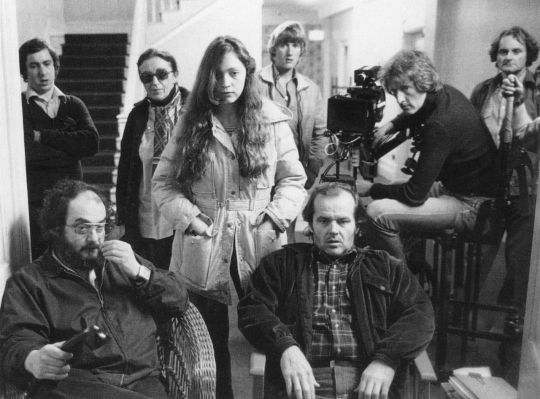
I realized that I didn’t include my watching of the Parks And Rec special thing that was on. By no means was it perfect, though I imagine that it was the best case scenario for something like that (in terms of being an original story, as opposed to a table/script read that the Community cast put together that’s coming out...ur, at some point). Is it necessary as a piece of media? It raised a lot of money for Feeding America and did its best in trying to shine some optimism in really unsettling times. Kinda nice.
Sunday, May 3
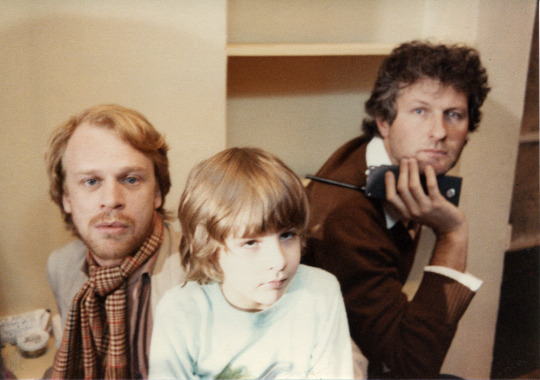
Filmworker, Zierra 2017 [as of now this is available on Netflix]
Interesting take on a documentary about, but not about Stanley Kubrick. It would be unusual for any Kubrick dude to not know or have some kind of inkling that he was a complicated figure (an asshole), especially when it came to making movies, so the point of the movie isn’t really to inform that aspect of of it (though it probably confirmed suspicions, should you have any). It’s more a case example of how toxic relationships like these work and how dangerous it is to deify people, especially your own heroes. Of course, should any of us be given the opportunity to work or be near someone we look up to, how’re do we know what our breaking point is for them before we reach it (unfortunately for Leon Vitali, it wasn’t until Kubrick passed away that he could see just how far deep he was). This is also a pretty good example of how companies and corporations will treat you like garbage just to advance their credibility and how sometimes it feels like a documentary’ll show you that but not really do anything change that (as far as I know).
Mad Men, [season 4 premier] “Public Relations”, “Christmas Comes But Once A Year”, “The Good News”, “The Rejected”
So I definitely haven’t watched Season 4 as a more grown person than I was back in high school when this first aired. So I’ve known Don’s life is a nightmare, but never really processed why or thought about why; I was not the most keen observer (probably because I was thinking about not turning in homework). Now with all that said, jeeeeeeez Don’s life is a super depressing nightmare oooof. Now Season 4 feels like it needs some more runway to catch up with itself and its momentum it revved up to at the end of season 3, so the first couple of weeks feel a little wobbly (though wobbly Mad Men is leagues better than some other dramas at their best). However, the Don and Lane friendship does gets established in this slew of episodes, two men who couldn’t be more different, but can’t help but be bonded by a miserable moment in time.
Three Busy Debras, “Barbra”
Holy shit this episode is so genius. So many shades of Stangers With Candy in this one.
Rick And Morty, “Never Ricking Morty”
Believe me, I don’t want you to know that I watched this either.

The Last Dance, Parts 5 & 6
These were probably my favorite parts of the doc so far, probably because its the most enjoyable stuff you can watch (hold for destroying any chance Charles Barkley had at winning a championship). Jordan as a brand, both figuratively and literally-the concept of celebrity through a Michael Jordan lens; I could lap that up for hours. It makes me mad that there’s only two hours left (now), because there’s clearly so much more that could be covered, but will leave unturned (more on this next week).
Monty Python: Almost The Truth (Lawyers Cut), “The Not-So-Interesting Beginnings”
Good example of the subjects not getting in the way of the subject matter. Probably the thing that leaves to be desired is seeing the remaining members (this was made in 2009, so Chapman was the only deceased member at the time) together and interacting with one another. You get a little bit of Michael Palin and Terry Jones together, but not in an interviewed capacity, which faintly scratches that itch. If I had to guess, I’d say that they all don’t love being together without Palin there as a buffer, just based on what I know about Monty Python. Lotta strong and brilliantly smart personalities with no real acknowledgement on who’s the best, because they all think they’re the best (maybe not Palin or Jones). Also, this is a surprisingly self-aware interview with Idle, which really shattered any preconceived notions I have for him-might have to do some self-evaluation.
Monday, May 4
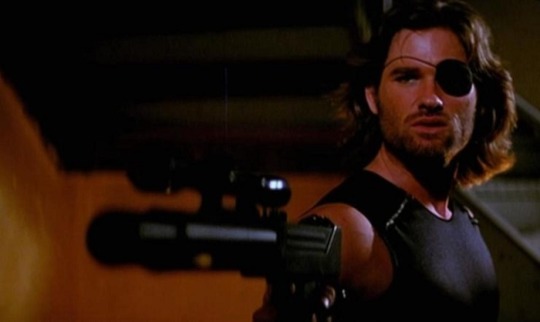
Escape From New York, Carpenter 1981 [as of now this is available on Prime]
I’ve definitely lied to people about having seen all of Escape From New York before. Why? Because it made me appear better than I actually was. It and Die Hard With A Vengeance (another great New York movie, though for the record, I’ve still never seen all of it) seemed to be two movies that I kept catching just enough glimpses of throughout the years without having actually seeing all of it. For instance, I had no idea that Harry Dean Stanton was in Escape From New York, which instantly elevates movies for guys like me from being “pretty good li’l B movie” to “this is actually advanced and high art” (this isn’t always the case on the HDS matrix, but it is consistent, see Repo Man).

Mad Men, “The Chrysanthemum And The Sword”, “Waldorf Stories”
Real fool me once with your racism shame on you you, Roger Sterling. Fool me twice, shame on me (re: “The Chrysanthemum And The Sword”). “Waldorf Stories” is really the first episode put in gear this season, maybe it’s because we’re getting Ken Cosgrove back (hell yeh) or maybe it just feels that way because “The Suitcase” is next and I know it; it’s an incredible build-up, what with hindsight and all that.
Tuesday, May 5

Mel Brooks: Unwrapped, Yentob 2018 [as of now this is available on HBO]
Listen, this isn’t very good. I think some of it has to do with Brooks, who kind of gets in the way of it all, which is a very hard thing to admit. It’s got some moments, when it actually tells you something about Mel Brooks, but for the most part its just a British guy not taking command of his own documentary and subject and that’s just like barely interesting. Mel Brooks is still a king, though.

Mad Men, “The Suitcase”
This is regarded as the best episode of Mad Men and one of the best episodes of television in the 2010s. I don’t know how it stands up by itself, like I don’t know if it resonates well with someone who’s never watched Mad Men outside of the vacuum. Usually going into one of these episodes that almost transcends its own show I tend to be weary, be it brand new (like when I watched “Pine Barrens” for the first time when I watched The Sopranos) or on a re-watch like this. I trick myself into thinking “well I bet its not that good” because you’re told to the contrarian take is the most interesting take, but I didn’t with this one. I remember the first time I watched it and I don’t think I’ve gone back and watched it in years, so I had forgotten almost all of the context around the episode, except for the argument. This episode is really special, hands down. Don’t love the ghost, but pobody’s nerfect. This podcast talks about it way better than I ever could, listen to that instead of reading this (I just want yer clicks, suckers!)
Wednesday, May 6
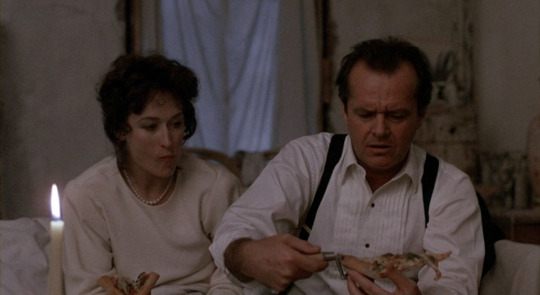
Heartburn, Nichols 1986 [as of now this is available on Prime]
I say this as someone who doesn’t travel in Mike Nichols circles (though this is the fourth movie of his that I’ve watched during all this, so maybe I do and I just don’t know it), but why isn’t this trotted out more as one of his best movies? My Nora Ephron bias might be showing a lot here, someone I didn’t really appreciate until I watched Everything Is Copy about a year ago (it’s an HBO doc-meaning it’s available on that platform if you want nice documentary to watch sometime), but this movie’s great! And it has two of the most famous movie stars to ever live as the two lead roles and Jeff Daniels as a bit player. And yet its legacy only feels relevant to those who seek out Mike Nichols or Nora Ephron movies, which feels odd, considering one half of that creative team is best known for The Graduate and the other for When Harry Met Sally (or Sleepless In Seattle or You’ve Got Mail).
Thursday, May 7
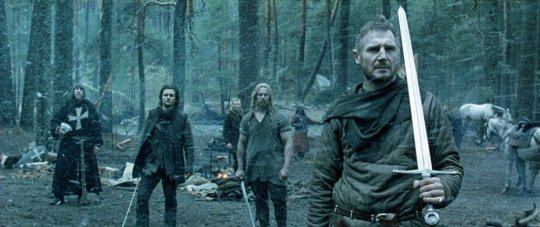
Kingdom Of Heaven (Director’s Cut), Scott 2005
I’ll be honest, I wanted to watch Return Of The King, but that just wasn’t an option. This movie’s technically good, like more Ridley Scott movies are than they aren’t, but really lacks any kind of new message besides “Religion’s pretty fucked up how it made people do that, huh?” Which to a lot of people is super appealing, but when you make a movie that only exists because of Lord Of The Rings’ success, you’d hope for something more (though isn’t this always the case with these kinds of movies?) Like make the movie about David Thewlis or Jeremy Irons. Obviously the battle/fight sequences are really cool to watch and look at, and that’s not an at all terrible critique to give it either. It’s fine that there’s dumb-guy Lord Of The Rings (which is semi-controversial considering a lot of the book nerds already consider Lord Of The Rings [movie] is dumb-guy Lord Of The Rings).
Mad Men, “The Summer Man”
Ah yes, the Don journals and goes swimming episode. It’s good considering it has to follow up “The Suitcase.” I can’t think of any from this particular episode, but (and I think it checks out, cultural timeline wise too) this is the season where it almost feels like the writers/directors figures out that their show was ripe for meme-dom and .gifs-sometimes when that happens it goes real south for the sake of quality, but luckily not Mad Men.
Friday, May 8

Jiro Dreams Of Sushi, Gelb 2011 [as of now this is available on Netflix]
I bet David Fincher loves this movie. I’m not a huge sushi lover (it’s fine, but way too expensive) so I guess I’ve figured that’d be a huge barrier for me to jump over to enjoy this doc. This thing’s got a weird, but great energy to it, where it feels like four twenty-minute segments sewn together; right when you think “well this should’ve just been a quick package on Frontline” it adds another wrinkle. Would probably be constructed more differently now, considering how food docs/series’ work now, but its strengths lie in its simplicity.
Top Chef, Season 17 episode 8
Great Restaurant Wars this season. Very compelling stuff and almost athletic. Andy Greenwald said it best.
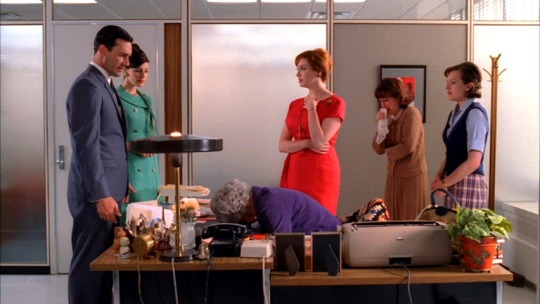
Mad Men, “The Beautiful Girls”, “Hands And Knees”, “Chinese Wall”
“Beautiful Girls” is another entry into the best Mad Men episodes (though like “The Suitcase” I don’t think it would necessarily resonate out of context). Iconic closing shot and a great Sally Draper episode, who I’ve feared I might’ve been overrating for the last couple of years. Nah, Sally Draper is underrated even. Big spiral moves for Don as well in here, though hopefully he can course correct after tasting Sally’s rum-cooked French Toast (it won’t!)
Saturday, May 9

Basic Instinct, Verhoeven 1992
I can’t imagine what it must feel like to be completely neutral about this movie; your life must be so care-free, so calming, so unconcerned with trying to figure out how exactly to start calling your close friends either “cowboy” or “hoss” as if you’ve been doing it your whole life. Also, listen, I get it about that one shot and it being the thing people kept talking about and the thing most associated with this movie, but nothing and no one prepared me for seeing Gus in a cowboy hat in that bar/club before the Nick/Roxie chase. That and all the ice-pick stabbings. And the opening crime scene. And a whole lot of other stuff that takes place in this movie.

Mad Men, “Blowing Smoke”, “Tomorrowland” [season 4 finale], “A Little Kiss Part 1 & 2″ [season 5 premier]
The letter! Disneyland! Marriage again! A lot of things happen in these four episodes that are the end and beginning of seasons. But when I realized that I was going to get “Zou Bisou Bisou” in this block of episodes, it was game over. I’ve had it stuck in my head every day for a prolonged amount of time since Saturday and the only thing that makes it not terrible is knowing how pissed off Don was that it happened to him. Don’t marry a 25-year-old. Season 4′s a weird one for Betty as the show tried to navigate how to keep her involved with the show even though she and Don aren’t married anymore and it’s not....great. Probably because they keep making her “true” emotional foil children (specifically Glen and to a greater level Sally, but the tribulations that come between a mother and almost teenage daughter shouldn’t be the same as a mother and some weird kid down the block who just happens to be the son of the show’s creator).
1 note
·
View note
Text
Ep6, Chapter 3 (Part 1)
Who decides who has the right to fall in love, and who decides who is or isn’t “furniture”?
oh god the chapter starts with hope i’m not ready for this
We get a quick recap of how things usually go - the typhoon hasn’t arrived yet though it’s fast approaching, Team Natsuhi is concerned about covering up Kinzo’s death again, Jessica and Kumasawa have left to go pick up the rest of the family on Niijima, and so on. Shannon and Kanon are busy preparing the guesthouse.
Shannon mentions that she likes cleaning the guesthouse (even though the mansion has more than enough rooms for the whole family), and Kanon says, “Yeah, it’s nice and quiet without Madam and all the annoying servants.”
The two of them discuss Shannon’s carelessness, but interestingly, instead of shrinking away from Kanon’s criticism, Shannon smiles and thanks him for helping. This is actually really interesting, I’d forgotten how much more... assertive, for lack of a better word, Shannon is here. Hell, when Kanon says “there’s nothing to thank me for,” Shannon calls him out on just wanting to spend time with her, saying he’s “such a kid.” She doesn’t even blush when he mentions George.
Maybe I’m reading into it too much, but hmm. It kinda feels like it’s a reflection of Tohya’s memories of what Shannon was like, in 1980? It’s true that Battler met Yasu face-to-face more than once (Shannon, Kanon, herself as Beato towards the end) on Rokkenjima Prime, but... well, his first impression of Kanon is unsociable and awkward. It’s true that Shannon is kind of clumsy, easily embarrassed, and shy, but thinking back to previous episodes - the narrative sorta put young Shannon in a bit of a “big sister” role to Battler and Jessica, didn’t it?
What I’m trying to say is, it reads to me like Tohya’s drawing on his memories of a “big sister”-esque Shannon, circa 1980, and extrapolating that to 1986. Of his four episodes, we don’t get a focus on Shannon and Kanon alone together very much - they die right off the bat in Ep3, they’re surrounded by the other adults in Ep4, and Ep5 is more focused around Natsuhi.
I’m not really sure what I’m driving at with this, or if it means anything. It’s just kind of an interesting parallel to Yasu’s Eps - there, Kanon was definitely the one “in control” during some of their scenes together (I’m thinking mainly of when she’s invited to play cards with the cousins), whereas here, Shannon is definitely leading the conversation. At any rate...
“You keep making fun of me and George-sama... but how is it going between you and Jessica-sama?” STRAIGHT TO THE POINT HUH
And when Kanon tries changing the subject, Shannon pushes him onto the bed and asks why he opted not to welcome the rest of the family with Jessica. He puts up a weak protest of, “Because I have work to do.”
“Liar. You don’t actually have any work at all.” yeah well you’d know wouldn’t you
“Normally, Kanon was the one in control, but when it came to romance, it was the opposite.” Interesting that the narrative decides to make that note, seeing as Shannon was pretty clearly “in control” before the subject turned to romance!
Even putting Jessica/Kanon aside, though, I can think of another very good reason for her to decide against meeting the relatives - Battler. Kanon and Battler’s first encounter in the rose garden didn’t go smoothly, but in that case, she had the advantage of being able to run away and hide. If she were on the boat with the relatives the whole way from Niijima to Rokkenjima? Not so much.
“...Despite what happened after the cultural festival, [Jessica] really does like you, Kanon-kun.” He reacts, seemingly in disbelief. “Even though... I’m furniture...” And this time, Shannon calls herself furniture as well in response. This really is almost a complete reversal of how things were in, say, Ep2 - Kanon is pretty reactionary here, as opposed to his proactive “stop it nee-san we’re furniture” approach earlier.
Kanon repeats the refrain of “we can’t love humans because we’re furniture,” but Shannon makes an interesting comment in response: “Maybe we’re furniture... just because we think that.”
I can get two meanings out of that - from a Yasu standpoint, this is the kind of internal argument she’s been having for a very long time. The emotions are what makes love what it is, not the physicality, so she shouldn’t have anything to fear in revealing her true form to George, or Jessica, or Battler. They should love her for who she is, not what.
...And yet, on the other side, there’s what Beato says. Yasu’s secrets are so much deeper than just some negative emotions or thoughts she’s had from time to time - in the case of Shannon and George, their whole relationship is built on one of her “secrets,” and to Yasu, there’s a very real danger of the whole thing coming crashing down on her if George learns the truth. While I’d like to think that, for all of my ragging on him, George would truly be able to accept the truth about “Shannon,” there’s absolutely no question that the nature of their relationship would change from then on. The same goes for Jessica and Battler. She’s trapped between “They love me for who I am, it’ll be fine,” and “I’ve been deceiving them and lying to them for years, no one could forgive me for that.”
...And that’s without getting into all the complicated emotions that are around her relation to Kinzo...
Carrying off of that, the second meaning: it’s meant as a message to Yasu, from Tohya/Battler. Even knowing the full weight of the secrets she’s carrying, and how much she’s tearing herself apart in agony, he’s saying, “I - we - would still love you.” Sort of like how George and Jessica’s fantasy fights in Ep4 were a “love letter” about how much Shannon and Kanon - and by extension, Yasu, even if they weren’t consciously aware of her - meant to them.
And, you know what? I can really, truly believe that all three of them - Battler, Jessica, and George alike - would still love her. The nature of their relationships would most definitely change, but I can readily believe that their love would still be there. We already know Battler did, to the point of throwing away his own identity for her; even if it’s one-sided, George’s passion and determination about making the family accept his engagement with Shannon (or, if they won’t, how he’ll leave them behind) is extremely strong; and while Jessica’s infatuation with Kanon might be fundamentally due to her emotional needs (how much she wants to fall in love), there’s also her friendship with Shannon. Even if she’s a bit thoughtless in how she treats Shannon from time to time, I think that friendship means an awful lot to her.
Anyways, back to reading. Kanon states, “I don’t have any special feelings for Milady Jessica. I only think of her as the daughter of the family we serve.” O-ouch, Yasu...
“You know... there is a chance that George-sama... will propose to me tonight.” And Kanon’s expression changes immediately. They both know exactly what that means.
“You really think you can marry a human even though you’re furniture?” Shannon calmly replies, “I think I can.”
Y’know, if this were any of the first four Eps, I’d know how to read this immediately: “I think I can” means that Yasu’s made up her mind. Her roulette starts spinning at midnight.
In the context of Ep6, though... I’m not immediately sure what to think. Maybe it’ll get a bit clearer as I read more of it. (I’m actually going to make a note to come back to this exchange once I’ve got a better picture of the Ep as a whole)
“That dream future that George-sama has imagined for you two... is something you can never give him.” Oh shit. I completely forgot that Kanon lays it out that bluntly. Tellingly, Shannon hesitates in response, in contrast to her confidence throughout the scene this far.
“I’m impressed you’ve managed to trick him for this long. Do you really think you can keep tricking him like that forever? Even though you still haven’t been able to tell him that you’re furniture?” As utterly terrified (and not without good reason, mind!) Yasu is about telling the truth to anyone, she still resents herself for not being honest, still feels like she’s lying to everyone about who she is. As much as I do believe that the cousins would understand just how heavily everything was weighing down on her if she did come clean, I can also very easily see why it’s such a frightening prospect to her. Which, again, is a conflict she has herself:
“...Being furniture or being human... has nothing to do with this. I believe that George-sama will accept all of me.”
“And yet you don’t have the courage to check and make sure.” Shannon doesn’t reply, instead switching tracks to saying that she’ll probably accept George’s proposal.
Shannon’s lack of response here is interesting to me. If she had replied, even if it were to just reaffirm “I’m sure George will accept me,” then I’d read it as a reassurance from Tohya - that Yasu doesn’t need to be frightened, because the emotions behind her relationships are very real, and very strong.
The fact that he didn’t put such a “love letter” in at this moment, though... I think it’s a gesture of respect. To contrast, when Yasu is utterly horrified to learn of Kinzo’s assault on Beatrice II, Genji, Kumasawa, and Nanjo (from what I recall - it’s been a while since I read Confession) all jump to Kinzo’s defense, explaining how he was in pain and how much he was suffering.
Which, I feel, is true! Ep7′s depiction of Kinzo and Bice’s interactions do make me believe that he would’ve suffered a great, great deal at her death. The thing is, in telling Yasu that when she reacts with disgust and horror, they’re effectively invalidating her own feelings. She’s horrified, but Kinzo didn’t mean to rape his daughter, he was hurting too, so please don’t hate him too much? Intentionally or not, they’re making her feel like she’s being irrational in reacting so strongly.
In comparison, Tohya’s writing doesn’t admonish her for being so scared. There’s no sense of “Don’t be afraid, you should know we’ll accept you,” - which, given Yasu’s intense self-loathing, would probably sound to her like “If your love for us was real, you’d know we’d accept you, you wouldn’t be afraid of telling us the truth.”
Instead, while he does reinforce throughout his writings that, yes, the cousins really, truly did love her (albeit based on what little they knew about her), he doesn’t push that she “should’ve” been brave enough to speak up. He respects her feelings on the matter and doesn’t invalidate them, even as he tells her how much he loves her in her entirety.
Anyways. “As Shannon looked up at the ceiling, she spoke of the imagined future that she and George would create. Though some anxiety over the future appeared on her face... so did joy from discovering what it was like to live with love.”
Kanon says that she’s “incredibly stubborn,” and she replies, “I want to live life my own way. ...I’d like to stop being afraid, about who’s furniture and who’s a human.” Yasu...
Kanon sulks over to the window, reflecting on how Shannon’s tale “had no chance of a happy ending. ...However, he also knew that no words of his could change her mind now that she had made her decision.” The harsh truth of the situation is that, no matter how much Shannon postures about how “being furniture” shouldn’t matter, about how she’s sure that George can accept it... Yasu still can’t bring herself to believe any of it.
Kanon asks why she’s even bothering talking to him about it, and she says, “What I want to know... is how you feel about Milady.”
As usual, Kanon denies having any attachments to Jessica, and Shannon immediately calls him out.
“Why do you think that’s a lie?” “I know. I’m your big sister. [...] I know everything about you, Kanon-kun.” ahahaha oh man
“I’m rooting for you in the only way I can!! Otherwise... even I...!” Shannon asks him to finish that thought, and he screams, “Even I... wanted to love Milady...!!!”
At Shannon’s prodding, Kanon lets out how he really feels about Jessica. It’s pretty easy to read in terms of Yasu - she’s confronting her own emotions, and finally finding a word to put to them: love.
“In fact, by saying it aloud, he finally understood how he truly felt.”
“Both of us are exactly the same, locked up on Rokkenjima and living without any hope at all...! And yet, Milady was able to light her own path and create her own fate...! She was so dazzling that I envied her!! I felt as though, if I could be with her... I could find my true self, instead of the pitiful person I am now...!!” Oh lord, does this hurt to read.
On one hand, like with Jessica urging Kanon to try her “create another self” thing way back in Ep2, I get a strong sense of bitterness from this dialogue, for the exact same reason - “I’ve already been fucking doing that and it’s not working, stop tormenting me with that,” if you will.
On the other hand, though... I can kind of imagine these being Yasu’s own, raw thoughts on the matter. If Jessica’s able to find a way to truly be herself despite the burden she’s shouldering, then maybe... if Yasu were by her side, she’d be able to, too?
Kanon reflects on how much it hurt to reject Jessica after the cultural festival. Said it before, will say again: I’m sure that Jessica wasn’t the only one crying herself to sleep that night...
“You know what? Whether or not you deserve to fall in love is something that you decide for yourself. Being furniture or not has nothing to do with it.”
I just want to let that line stand on its own for a moment.
Ultimately, that’s the one thing Tohya is trying to tell Yasu through his own writings, and one of the things Umineko itself has been quietly poking us with all along - that everyone is deserving of love, of having someone reach out to try and understand them, of having someone see them for who they truly are underneath the mask they present to the world. That everyone is human, everyone carries both the potential for kindness and cruelty inside of them. That making the effort to see and understand someone’s heart is difficult - but it’s worth it.
With that, Shannon “grants” Kanon the right to fall in love. He thanks her, feeling “as though I can finally... see the sea...”
Shannon reinforces that she’s decided on accepting George’s proposal. “I intend to leave this island and start a new life in our new world. [...] I’ll leave this island... and after that, I’ll never return again. ...I’ll have to say farewell to you, Kanon-kun.”
And then it gets interesting: “If you do love Milady from the bottom of your heart, and if your feelings are at least as strong as my feelings for George-san... then you and I will have to settle whose feelings are really stronger.”
“This way is best for both of us. ...Don’t give up on your feelings for my sake.” “Even though my selfishness might keep you from your happiness...?” “I’m fully aware of it... My happiness... is hurting you as well.”
“We have no choice but to hurt each other.”
“...Nee-san. Living with you... made me happy.” “Me too. I wouldn’t have lasted this long without you.” “...And I wouldn’t have realized how dazzling Milady is... if it weren’t for you.”
The two of them decide that no matter what the outcome is, they’ll celebrate and support whoever wins.
“After all, by now... We are not furniture.”
2 notes
·
View notes
Photo
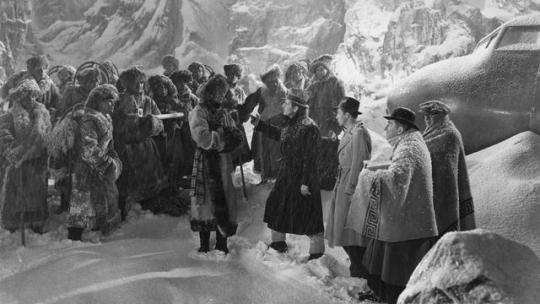
Lost Horizon (1937)
Asia and Europe were about to plunge into warfare when Frank Capra’s Lost Horizon was released in American theaters. The Chinese, mired in civil war between the Communist Party and the nationalist Kuomintang, were about to find a common enemy in the Japanese. Meanwhile, Nazi Germany continued its saber-rattling, leaving other European states looking nervously towards the continent’s increasingly militarized center. At this time, Americans, still reeling from the Depression and not yet too concerned about enforcing Wilsonian human rights elsewhere, longed for escape, for being sheltered from the news and conflict and suffering. A utopia, a Shangri-La, must have seemed appealing. The Shangri-La depicted in Lost Horizon – based on James Hilton’s 1933 novel of the same name – might fit the bill, without closer inspection.
It is 1935 and soon-to-be Foreign Secretary Robert Conway (the reliable Ronald Colman, performing solidly in this outing) is a diplomat working to evacuate as many white people as he can from a city under attack from Mao’s Communists. The Chinese heathen can fend for themselves, I guess. Among those climbing aboard the diplomatic plane to Shanghai are Conway’s younger brother George (John Howard), paleontologist Alexander Lovett (Edward Everett Horton), criminal Henry Barnard (Thomas Mitchell), and the terminally ill Gloria Stone (Isabel Jewell). Their plane has been hijacked and crash lands somewhere in the Himalayas. A Shangri-La native, Chang (H.B. Warner; one of many white actors playing an Asian character), rescues the British subjects and leads them to his home, a lush valley where the residents age much slower and are shielded from the brutal Tibetan weather. There, George is enchanted by a lady named Maria (Margo) and Gloria’s ailments have disappeared. Conway also meets the High Lama (Sam Jaffe), who eventually reveals that their arrival in Shangri-La has not been by chance. When the British characters raise questions about contacting the outside world, their questions are left unanswered.
With an original runtime of six hours, then trimmed to three-and-a-half hours, and finally settled for a runtime of just over two hours (today, the film is considered partially lost, but more on that later), Lost Horizon’s screenplay – penned by Capra regular Robert Riskin (1934′s It Happened One Night, 1941′s Meet John Doe) – appears to be an amalgam of ideas, tossed like a salad, that combine into an unfocused end product. The notion of Shangri-La and its inhabitants is proclaimed to be universalist, for the bounty of all those looking to coexist with others. But Riskin’s adaptation of Hilton’s novel adheres to Hilton’s conception that Shangri-La was once inhabited by native Tibetans, and that those Tibetan leaders were replaced by European wanderers who introduced Western knowledge for themselves, not for the Tibetans who could no longer attain an elite status. A “Christian ethic” where, “the meek shall inherit the Earth” is considered superior to other structures of social organization, according to the High Lama (as sociology, that’s just lazy writing). Riskin makes little attempt to either critique the existing organization of Shangri-La nor does he – outside of one lengthy soliloquy by the High Lama – use the shining example of Shangri-La to effectively juxtapose life in the Himalayas with life in places soon to be reduced to charred, damaged battlefields. However, as a fantasy film, Lost Horizon wonderfully constructs the awesome settings described in the Hilton novel.
Though few in 1937 criticized Lost Horizon for its Atlanticist imperialism upon release, those features are more apparent eighty years later. Considered a masterwork from Frank Capra, the film has aged poorly on how it treats the Asian setting and individuals that it depicts. Though the High Lama and Chang mention the diversity of Shangri-La, we only see white actors in yellowface playing the leaders as the actors of Asian descent play the speechless grunts patrolling the settlement. The High Lama’s functions are an embodiment of the perceived religious, cultural, and technological superiority of the West combined with an awkward mysticism that stems from exotic places. The backwardness of any Asian characters reduces them to grinning, violent caricatures.
Yet where Lost Horizon succeeds as a film – though despicable in its racialized writing and portrayals – is in its technical components. Cinematographers Joseph Walker and Elmer Dyer are allowed immense backgrounds to work with, allowing for an incredible scope to the production not often seen after the free-spending epics in the later silent era. Editors Gene Havlick and Gene Milford play with the film’s practical visual effects in groundbreaking fashion for the time. Some of their visual tricks, borrowing heavily from the later silent era, make any miniatures or matte paintings that appear to seem realistic. With a then-astronomical budget of $2 million (~$34 million in 2017′s USD), Capra lavished much of that money from Columbia Pictures – in 1937, Columbia was not quite a major studio on the level of Warner Bros. or Metro-Goldwyn-Mayer (MGM) yet – on the production design by Stephen Goosson. Goosson and his staff built sixty-five sets, constructing the walls and buildings of Shangri-La at Columbia’s ranch in Burbank. Extensive research also produced replications of upwards of 700 props used in Tibetan life. This expansive collaboration of cinematographers, editors, and production designers help Lost Horizon to transcend its Orientalist trappings, its troubled writing, if only to a limited extent.
Lost Horizon presented a breakthrough for composer Dimitri Tiomkin, who would become Frank Capra’s favored composer through You Can’t Take It with You (1938), into Capra’s Why We Fight WWII propaganda series, and until It’s a Wonderful Life (1946). Over this next decade, Tiomkin’s concentration on piano and European classical music expanded to grand orchestral works with American influences thanks to his friendship with Capra. But for this first score for a Capra film, the strings dominate the faux Eastern-sounding melodies – there is a long history of European composers trying to imagine Asia through their music. Although in too many places (especially in the opening half of Lost Horizon), Tiomkin’s brass is too harsh where he should be more delicate with his passages. Yet there are gorgeous cues contained within Tiomkin’s composition, most notably during the swimming sequence and the resolving sequences of the film – this includes the funeral procession (perhaps the most memorable cue of the score, thanks to a wordless choir) and an attempted flight from Shangri-La. This is one of Tiomkin’s greatest works, with a curious orchestration and thematic development that would be recalled for his work in Land of the Pharaohs (1955).
Existing prints of Lost Horizon are partially lost. The print that I saw for this write-up was on Turner Classic Movies (TCM) and is the most complete edition available. This print is the one recommended for those interested in seeing Lost Horizon – the 1986 restoration by the American Film Institute (AFI) and the UCLA Film and Television Archive which runs 132 minutes and contains 125 minutes of footage. The seven missing minutes are accompanied by the film’s soundtrack (which thankfully exists in its entirety), but includes still images of the missing scenes. Do not watch any other prints other than the AFI/UCLA version – exceptions can be made, of course, if you stumble upon the original six hour print only shown to Columbia executives.
For Columbia’s co-founder and president Harry Cohn, Capra’s indiscretions of shooting excessive takes and ballooning production costs damaged his relationship with Capra. Unhappy with preview footage screened in January 1937, Cohn – believing that audiences would not be patient enough with a lengthy feature film despite the fact that some silent films ran over three hours or longer (1916′s Intolerance is 210 minutes; 1923′s La Roue is 273 minutes) – eventually seized Capra’s film from him and cut Lost Horizon down to the familiar 132 minutes seen in its roadshow format. Decades later, Capra still would not forgive Cohn for how he treated the final cut of Lost Horizon.
Confounded by too much exposition and an outdated portrayal of its Asian characters and cultures, Lost Horizon – like fellow 1937 release The Good Earth (a better movie with a more sensitive take on Asian characters, despite the rampant yellowface) – has the imagination of its artisans and craftspersons to make it one of the grandest Hollywood productions of the 1930s. The eleventh-highest grossing film at the American box office in 1937, Lost Horizon provided a temporary utopia for Depression-era audiences yearning for such an escape. The Library of Congress’ National Film Registry - a collection of American films regarded as national treasures, and marked for preservation - recognized this, inducting Capra’s film into the Registry just last year. For some characters in Lost Horizon, Shangri-La is paradise found. For others, a prison. Modern audiences might scoff without much thought when considering the elements that constitute Shangri-La. But for a certain people in a different time, whatever troubled Shangri-La probably was more easily forgiven.
My rating: 8/10
^ Based on my personal imdb rating. My interpretation of that ratings system can be found here.
#Lost Horizon#Frank Capra#Ronald Colman#Jane Wyatt#Sam Jaffe#John Howard#H.B. Warner#Edward Everett Horton#Thomas Mitchell#Isabel Jewell#Margo#Robert Riskin#Joseph Walker#Elmer Dyer#Gene Havlick#Gene Milford#Stephen Goosson#TCM#My Movie Odyssey
3 notes
·
View notes